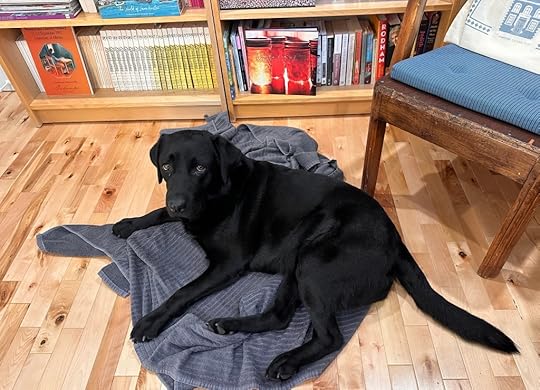Sarah Emsley's Blog, page 12
December 15, 2023
“Where to look for the threads”
I’ve been reading Eudora Welty recently. I started with One Writer’s Beginnings, which was a present from my sister Bethie, and I loved it so much that I immediately ordered her collected stories and essays. Reading Welty’s memoir and L.M. Montgomery’s The Golden Road around the same time made it possible to see links between the two writers that I might otherwise have missed.
Welty says, “Writing fiction has developed in me an abiding respect for the unknown in a human lifetime and a sense of where to look for the threads, how to follow, how to connect, find in the thick of the tangle what clear line persists. The strands are all there: to the memory nothing is ever really lost.”
These lines prompted me to return to the last pages of The Golden Road, in which the Story Girl’s father speaks of his love for her late mother: “How I loved her! How happy we were! But he who accepts human love must bind it to his soul with pain, and she is not lost to me. Nothing is ever really lost to us as long as we remember it.”
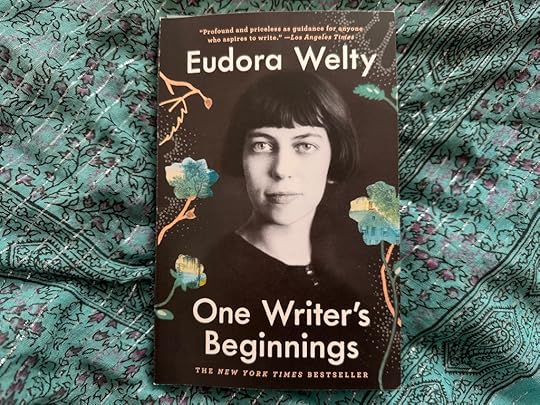
I chose this turquoise scarf for the background not just because it matches the cover of the book, but because I bought it in Boston the summer I was fourteen, when I was on my way to Welty’s hometown of Jackson, Mississippi, to spend a week volunteering for a charity similar to Habitat for Humanity.
I thought of the Story Girl’s love of roads when I read Welty’s account of travelling with her parents, with her mother giving directions while her father drove: “‘This doesn’t surprise me at all,’ she’d say as Daddy backed up a mile or so into our own dust on a road that had petered out. ‘I could’ve told you a road that looked like that had little intention of going anywhere.’”
Do you remember the discussion of fairyland in The Story Girl? Bev, the narrator, says the Story Girl is right that fairyland exists, but only children know how to get there, and when they get older they forget—except for “singers and poets and artists and story-tellers.”
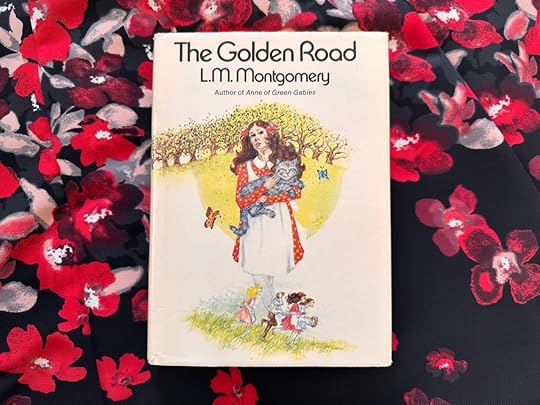
Welty writes that “Children, like animals, use all their sense to discover the world. Then artists come along and discover it the same way, all over again. Here and there, it’s the same world. Or now and then we’ll hear from an artist who’s never lost it.”
I hadn’t known before that Welty worked as a photographer in the 1930s, taking pictures of daily life in Mississippi. I enjoyed reading her description of what she learned from photography:
I learned in the doing how ready I had to be. Life doesn’t hold still. A good snapshot stopped a moment from running away. Photography taught me that to be able to capture transience, by being ready to click the shutter at the crucial moment, was the greatest need I had. Making pictures of people in all sorts of situations, I learned that every feeling waits upon its gesture; and I had to be prepared to recognize this moment when I saw it. These were things a story writer needed to know. And I felt the need to hold transient life in words—there’s so much more of life that only words can convey—strongly enough to last me as long as I lived. The direction my mind took was a writer’s direction from the start, not a photographer’s, or a recorder’s.
I recently read an article about Alice Munro in The Guardian in which Chris Power suggests that Welty is “a particularly discernible influence” on Munro: “both writers are fascinated by the doubling of the world as it’s generally seen, and the stranger one it cloaks.”
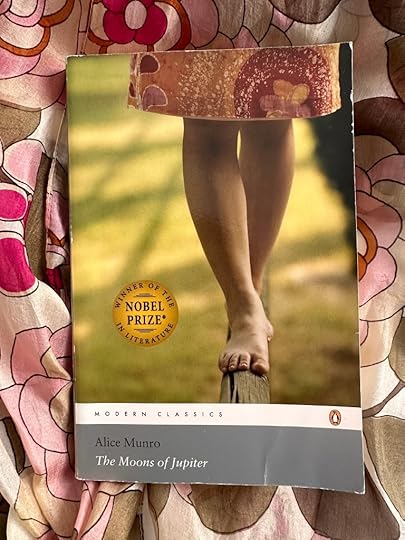
In both writing and photography, Welty spoke of “trying to portray what you saw, and truthfully. Portray life, living people, as you saw them. And a camera could catch that fleeting moment, which is what a short story, in all its depth, tries to do.” This New York Times article includes some of the photographs she took during the Depression, of tomato packers, farmers, a nurse, a Sunday School class, and a blind weaver. My sister Bethie is especially interested in that last one, “The weaving woman and the blind bard in one image. She has fused together Penelope and Homer, but in a local, contemporary, humble context.”
Natasha Trethewey’s beautiful introduction to One Writer’s Beginnings inspired me to look up some of her work as well. I like what she says in the introduction about how “Whether or not we are writers, we tell a story to ourselves about our lives, the art of them—what gives meaning and purpose, and connects us to others.”
I’ve said One Writer’s Beginnings was a present from Bethie. Let me go back and tell the story of how she came to give me this wonderful book. If you’ve been reading my blog over the past year, you’ll probably remember that Bethie was living in Bonn, Germany, and I travelled there to visit her and her family (and the Beethoven statue, and the house where he was born, and Cologne Cathedral, and the ruined castle at Drachenfels, among other places). Last December, in a lovely bookstore in Bonn called Thalia, I bought a copy of Ann Patchett’s recent collection of essays, These Precious Days, to read on the flight home to Nova Scotia.

The bookstore, Thalia, is in the Marktplatz, inside a former theatre (Metropol)
This past summer, Bethie and her family moved from Germany to Mississippi, and when they stopped in Nova Scotia for a couple of weeks on their way to their new home, I gave her my copy of These Precious Days, thinking it would provide good company because many of the essays are about life in the South. (Someday, Bethie and I would love to visit Ann Patchett’s bookstore, Parnassus Books, in Nashville.) In the fall, when Bethie was looking for a book to send me, she settled on something by Welty, because she had read Patchett’s introduction to Welty’s Collected Stories, which is included in These Precious Days. She bought One Writer’s Beginnings for me and the Collected Stories for herself.
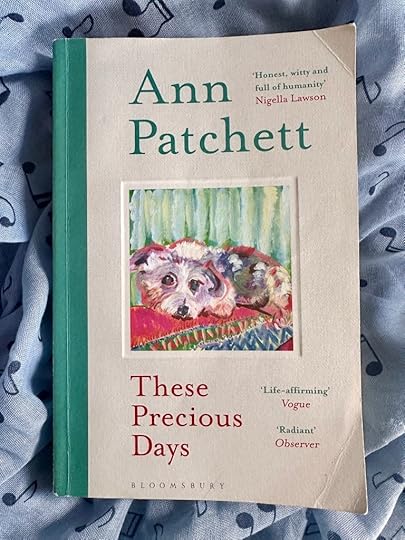
The blue scarf is from Beethoven’s House in Bonn
Patchett quotes Welty’s description of what it was like to discover Virginia Woolf, in 1930, “when I was young,” Welty says, “reading at my own will and as pleasure led me.” She read To the Lighthouse: “I fell upon the novel that once and forever opened the door of imaginative fiction for me, and read it cold, in all its wonder and magnitude.” Patchett encourages readers to reread Welty’s stories even if they’ve read them before, “because even as the text stays completely true to the writer’s intention, we readers never cease to change.” She praises Welty’s ability to “tell the truth of the landscape.” She says she could take the volume of stories apart “and type it up again, sentence by perfect sentence, to say, This is exactly what Mississippi is like.”
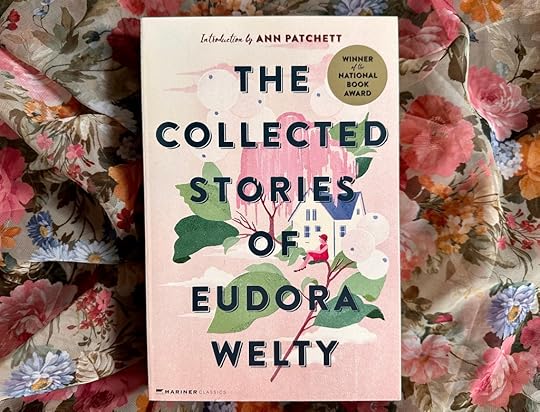
When Bethie first arrived in Mississippi, she was missing Beethoven, and the tradition of going for “coffee with Beethoven” in the Münsterplatz in Bonn. Maybe Welty is the new Beethoven? Or Elvis is the new Beethoven?? I’d like to see his birthplace in Tupelo. I haven’t been to Mississippi since I was fourteen, and I’m looking forward to making the trip, perhaps sometime in the coming year.
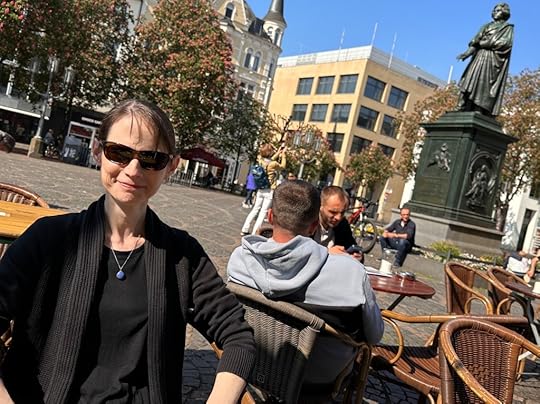
Bethie took this picture of me in May, the last time the two of us had coffee with Beethoven
I’d like to visit Eudora Welty’s house, at 1119 Pinehurst Street in Jackson, where she lived for almost eighty years. I was delighted to discover a reference to the house in the recent New Yorker profile of Kate DiCamillo, by Casey Cep. I had read this fascinating article when it was published in September—a rare example of me reading the New Yorker right away, rather than letting issues pile up for months before I start trying to catch up—but I hadn’t paid much attention to the part about Welty’s house because I hadn’t yet read One Writer’s Beginnings. Happily, my friend Lisa mentioned the article in November, and I read it again.
Here’s what Cep says about DiCamillo: “The closest thing to luxury in her house is two pairs of slippers: one under her desk, the other under her claw-foot tub. During a tour of Eudora Welty’s home, in Jackson, Mississippi, she was struck by the humanity of the novelist’s slippers, which were still waiting faithfully under her bathrobe long after her death. DiCamillo talked about them so much that her best childhood friend, Tracey Bailey, got her one pair, and her best writing friend, the author Ann Patchett, got her another.”
I’m still meditating on what Welty says about looking for the threads, “how to follow, how to connect.”
Some years ago, my daughter and I read Finding Serendipity, by Angelica Banks, in which the heroine, Tuesday McGillycuddy, follows a silver thread that leads her to the place stories come from. I like the idea of holding onto a thread that can help us return to the world of the imagination, if we’ve lost our way, or if the road we’re on turns out to be one that has “little intention of going anywhere.”
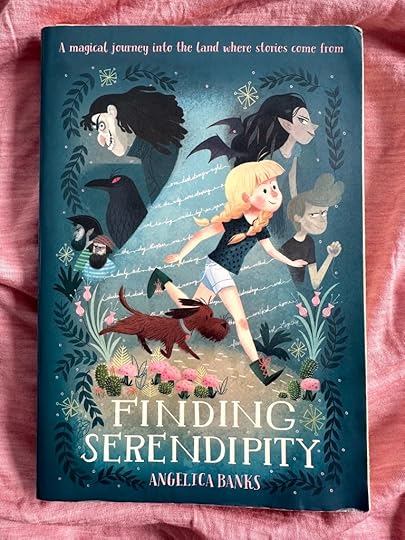
After we had read the book, I bought spools of silver thread for Bethie and my daughter and me. I keep mine on my desk, in a little dish filled with shells, stones, and sea glass, a letterpress S that a friend gave me years ago, and a ring I lost while swimming in the Atlantic Ocean when I was a child, which my Granny later found for me in a clump of seaweed after the tide had gone out.
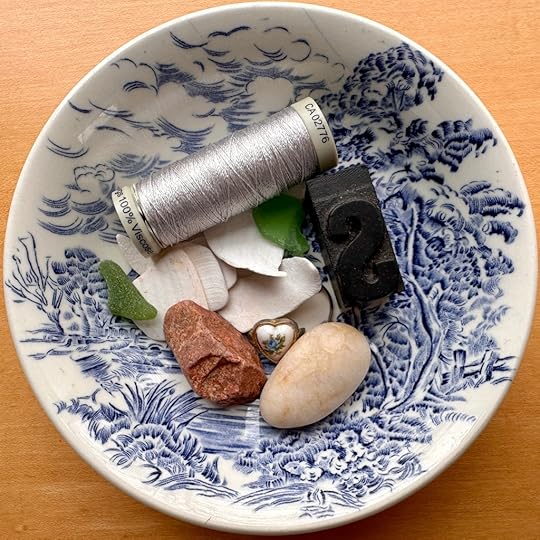
I’m mixing metaphors by talking about threads and roads at the same time. But if these metaphors help us find our way to the next story, whether it’s the next book we read or the next book we write or the next story we tell each other or ourselves, then I’m in favour of keeping them both, along with the ring and the letter and the treasures from the sea.
After I had read One Writer’s Beginnings, I followed the thread, or the road, to Natasha Trethewey’s Native Guard: Poems, which won the Pulitzer Prize in 2006. In “The Southern Crescent,” I read about her mother “leaving behind / the dirt roads of Mississippi” in 1959, “the film / of red dust around her ankles, the thin / whistle of wind through the floorboards / of the shotgun house, the very idea of home.” I read about her parents’ marriage in 1965 in “Miscegenation”:
A year later they moved to Canada, followed a route the same
as slaves, the train slicing the white glaze of winter, leaving Mississippi.
I read about her grief for her mother, who was murdered by her second husband. In “Myth,” Trethewey talks about “still trying / not to let go.” I thought of the Story Girl’s lament in The Golden Road for Paddy, the missing cat: “every night I dream that he has come home,” she says, “and when I wake up and find it’s only a dream it just breaks my heart.” Trethewey addresses her mother: “You’ll be dead again tomorrow, / but in dreams you live. So I try taking / you back into morning.”
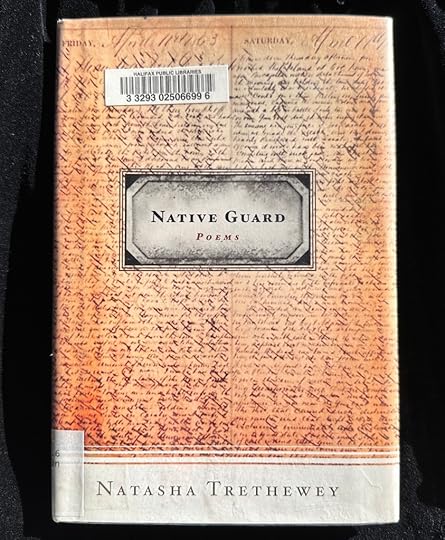
When Trethewey was appointed poet laureate in 2012, she that when she learned of her mother’s death, “Strangely enough, that was the moment when I both felt that I would become a poet and then immediately afterward felt that I would not. I turned to poetry to make sense of what had happened. … It took me nearly 20 years to find the right language, to write poems that were successful enough to explain my own feelings to me and that might also be meaningful to others.”
Like Trethewey, DiCamillo has a deep knowledge of suffering and grief. Cep writes that “One gets the sense from the books that DiCamillo knows that ‘deeper dark’ better than most of us, but she has, in the past, avoided letting on just how well.” Only recently has she spoken of terrifying scenes from her childhood, images of her father that are “darkened by fear,” and of how she made peace “with the torment she hadn’t wanted but without which she worries she would not have become a writer.”
I’ve read some of DiCamillo’s books, including The Tale of Despereaux and The Miraculous Journey of Edward Tulane, but I hadn’t read her first novel, Because of Winn-Dixie, and I started it a few days ago after my friend Susan recommended it. I’d also like to read Great Joy, a Christmas picture book that comes highly recommended by my friend Lisa. Ann Patchett writes about DiCamillo as well as Welty in These Precious Days; her favourite of all DiCamillo’s books is The Magician’s Elephant. She writes that the books “had given me the means to look backwards. … The work of Kate DiCamillo had opened something in me, an ability to see and feel things that were very far from me now.”
Let’s go back to Welty and Montgomery for a moment, who both say that “nothing is ever really lost.” Patchett says that what DiCamillo’s books gave her was “the ability to walk through the door where everything I thought had been lost was in fact waiting for me. All of it. The trick was being brave enough to look.”
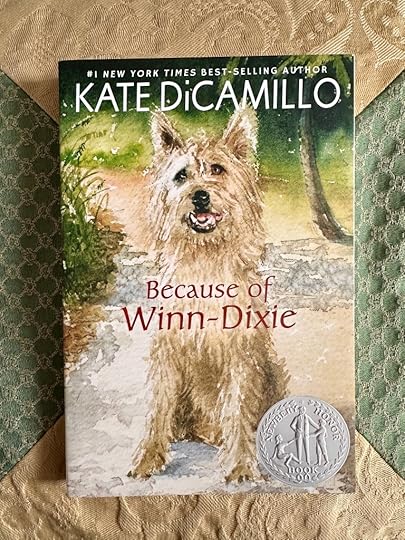
When I read about DiCamillo’s writing habits in the early years when she was also working for a wholesale book distributor, I thought again of Montgomery. DiCamillo used to “get up every day to write before her shift—first an hour early, then two hours early, at 4:30am, setting herself the task of producing two pages a day. She chose the predawn hours because neither the rest of the world nor her inner critic was awake yet. Sitting at a desk that her brother helped fashion out of a wooden fence from their back yard in Clermont, she wrote by candlelight and lamplight. She submitted short stories to every magazine for which she could find an address, including this one, and she kept submitting them long after others would have called it quits.”
In her autobiography, The Alpine Path, Montgomery describes one winter when she was teaching and felt too tired to write in the evenings. “So I religiously arose an hour earlier in the mornings for that purpose. For five months I got up at six o’clock and dressed by lamplight. The fires would not yet be on, of course, and the house would be very cold. But I would put on a heavy coat, sit on my feet to keep them from freezing and with fingers so cramped that I could scarcely hold the pen, I would write my ‘stunt’ for the day. Sometimes it would be a poem in which I would carol blithely of blue skies and rippling brooks and flowery meads! Then I would thaw out my hands, eat breakfast and go to school.”
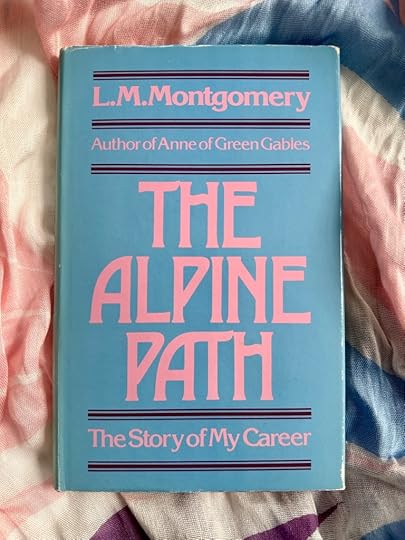
I suspect there’s a connection between this habit Montgomery developed, of being able to write about warmth and sunshine while working in a cold house, and her ability to write cheerful stories while enduring periods of disappointment and unhappiness. She dealt with many losses in her life, beginning with the death of her mother in 1876, when Maud was just twenty-one months old. As Mary Henley Rubio says in Lucy Maud Montgomery: The Gift of Wings, Montgomery later wrote in her journal that “three simple words had fortified and sustained her throughout a troubled life.” One night when she was sleeping at her cousin Pensie Macneill’s house, Pensie’s mother came into the room to check on the girls, bent over them, and said the words “Dear little children.” Maud was pretending to be asleep, but she never forgot these kind words that were so unlike the things her “stern Grandfather” and “reserved Grandmother” said to her.
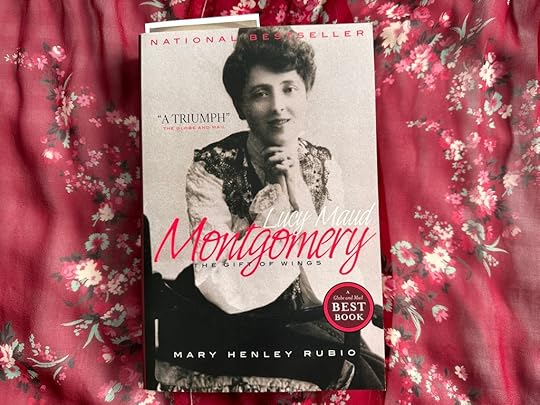
Trethewey, DiCamillo, and Montgomery have all spoken about the way difficult or traumatic experiences shaped their writing. By contrast, Welty says in One Writer’s Beginnings that she was “a writer who came of a sheltered life.” However, she says that “A sheltered life can be a daring life as well. For all serious daring starts from within.”
A couple of photos my husband took on his trip to Mississippi in November:


William Faulkner’s house, Rowan Oak
Well. I’ve written at length and I’m not at all sure I’ve found the “clear line” Welty talks about, but it feels important to follow the threads and make connections. To keep reading and talking about books, no matter how thick the “tangle” of the world we live in.
If you haven’t yet read One Writer’s Beginnings, I encourage you to seek it out. Read it for the description of Welty’s parents “whistling back and forth to each other up and down the stairwell,” when her father was upstairs “shaving in the bathroom and Mother downstairs was frying the bacon.” “Long before I wrote stories,” she says, “I listened for stories. Listening for them is something more acute than listening to them.” Read for the moment at which she was startled and disappointed “to find out that story books had been written by people, that books were not natural wonders, coming up of themselves like grass.” Read for the story of how as a child she made her way through the State Capitol to the library where the librarian allowed patrons to take out only two books at a time, and young Eudora knew the “bliss” of “the devouring wish to read,” and “The only fear was that of books coming to an end.”
I’ve dipped into Suzanne Marrs’s biography of Welty, and I’m intrigued by the range of responses to One Writer’s Beginnings: while many reviewers wrote of Welty as “shy and retiring,” saying (in the words of one critic) that she led “a relatively uneventful life,” later critics have drawn attention to the complexities of her life, beyond the image of her as the “happy child” of this memoir or as the “witty, elderly lady.” Perhaps her life was not as “sheltered” as she said it was. I’d like to read more.
I’m immersed in Welty’s essays now, and I was delighted to find that the first essay in The Eye of the Story is called “The Radiance of Jane Austen”: “The sheer velocity of the novels, scene to scene, conversation to conversation, tears to laughter, concert to picnic to dance, is something equivalent to a pulsebeat. The clamorous griefs and joys are all giving voice to the tireless relish of life. The novels’ vitality is irresistible for us. … Everybody doing everything together—what mastery she has over the scene, the family scene!”
I’m interested in reading more books by Mississippi writers, starting with Jesmyn Ward’s Sing, Unburied, Sing. I’d also like to read more by Kiese Laymon, whom I quoted in last week’s post—“READ when you’re angry”—and whose essay on gas station restaurants I enjoyed reading earlier this week. He says, “I’d never really thought about the fact that my favorite restaurants, as a child, as a teenager, as an adult returning to Mississippi, nearly all served gas. And I never, ever thought of them as gas stations that served food.” I’d be glad to hear other recommendations.
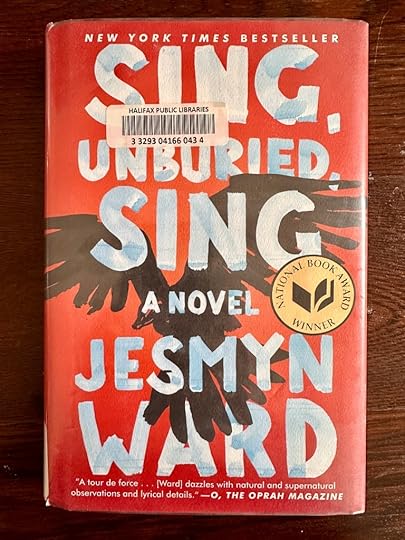
Many thanks to my dear sister Bethie for the gift of One Writer’s Beginnings. She told me recently that she had just finished reading Elizabeth Hay’s Late Nights on Air, “which I loved,” she said. Hay’s novel won the Scotiabank Giller Prize in 2007. “I guess it took me a while to get to it,” Bethie says, “but it somehow came into my hands at just the right moment. Having just moved to the deep South, I found Hay’s writing about the far North extraordinarily refreshing. Here’s to all the books waiting on shelves, in piles (or boxes), and on lists!”

I too loved Late Nights on Air, and Hay’s memoir All Things Consoled. I haven’t yet read her novel Garbo Laughs, which was honoured with a Project Bookmark Canada Bookmark in Ottawa, Ontario (you can see photos of the Bookmark plaque here) and since I’m a long-time supporter of Project Bookmark, I’ll follow the thread and add the novel to my list.
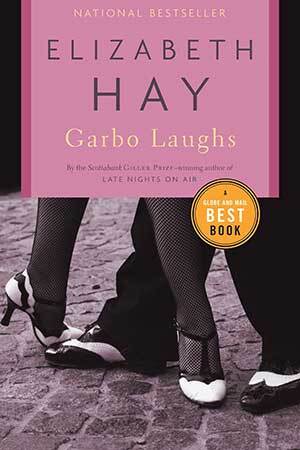
If you enjoyed this post, I hope you’ll consider recommending it to a friend. I’m always interested to read your comments and messages. Thanks for reading!
December 8, 2023
Prudence and Romance in the “Golden Crescent”: Uzma Jalaluddin’s Much Ado About Nada (plus some scrapbook notes and photos)
Uzma Jalaluddin’s novel Much Ado About Nada was inspired by Jane Austen’s Persuasion as well as (more obviously) by Shakespeare’s Much Ado About Nothing. I enjoyed reading scenes set on the University of Toronto campus and in the fictional Golden Crescent neighbourhood of Scarborough, Ontario, and watching the complicated relationship between Nada Syed and Baz Haq unfold. In chapters set in the present, they meet at Deen&Dunya, “a massive Muslim convention held in downtown Toronto” that’s “like Comic-Con, except with hijabs, jilbabs, beards, and kufi skullcaps rather than intricate fan-created costumes.” Nada has managed to avoid attending the convention—and seeing Baz—for six years, but when she reluctantly agrees to accompany her best friend, Haleema, she’s forced to confront Baz and thus also the secrets she’s kept for so long. In chapters set in the past, we learn about their history as adversaries and then friends, and about the romance that developed and the reasons they, like Austen’s Anne Elliot and Captain Wentworth, said goodbye despite the strong bond between them.

I took this photo of the University of Toronto campus and downtown Toronto last summer,

when my daughter and I visited the CN Tower.

Both Persuasion and Much Ado About Nothing are central to the novel. “Nada means nothing,” a childhood classmate and bully tells Nada. “You’re nothing,” he says (Chapter 3). Anne Elliot, despite her “elegance of mind and sweetness of character,” is “nobody with either father or sister; her word had no weight, her convenience was always to give way—she was only Anne” (Volume 1, Chapter 1). The spirited arguments between Nada and Baz echo those of Shakespeare’s Beatrice and Benedick in Much Ado or Austen’s Elizabeth and Darcy. Unlike Anne Elliot, however, who consistently responds to dismissive remarks from her family with patience and generosity, after Nada is bullied as a child, she acts as a bully toward Baz, and later gives in to the temptation to snoop in his notebook, where she finds poetry and a sketch of herself and begins to suspect his interest in her goes beyond friendship. It isn’t just the interference of a Lady Russell-like family friend that keeps the heroine and her hero apart, it’s also their own mistakes that prevent them from fully understanding each other. Although Nada apologizes, Baz refuses to forgive her and he disappears from her life yet again.
Like Wentworth, Baz criticizes those who are indecisive. “Let those who would be happy be firm,” Baz says (Chapter 14), echoing Wentworth’s precise words to Louisa Musgrove. But Jalaluddin isn’t just copying plot or dialogue from Persuasion. Here, as elsewhere in the novel, she offers a fresh perspective on the tensions between hero and heroine. In Persuasion, Anne overhears Wentworth’s conversation with Louisa; in Much Ado About Nada, Nada is present when Baz delivers this line, and thus she has the opportunity to respond to him and Firdous, the woman who, like Louisa, has boasted that when she’s made up her mind about something, she doesn’t change. Nada argues that “Seeking naseeha, sincere advice, and listening to people you trust when you’re unsure is natural.” Anne, by contrast, remains silent, and even immobile: “Her own emotions still kept her fixed. She had much to recover from, before she could move” (Volume 1, Chapter 10).
This isn’t the only situation in which Jalaluddin transforms a private moment from Persuasion into a more public one in her novel—but I won’t spoil the ending by describing the clever way she incorporates Wentworth’s famous “half agony, half hope” letter in her own work. Instead, I’ll end with her version of the line in Persuasion that Jane’s sister Cassandra said “deserves to be written in letters of gold.” Austen says of her heroine that “She had been forced into prudence in her youth, she learned romance as she grew older—the natural sequel of an unnatural beginning” (Volume 1, Chapter 4). Jalaluddin says of Nada that “Perhaps the prudence she had been forced into as a twenty-two-year-old could be shed, if only for one night, in favor of a more romantic memory” (Chapter 30). Readers may hope, with Nada, that the romance will last as she grows older, too.
More photos from the University of Toronto campus:


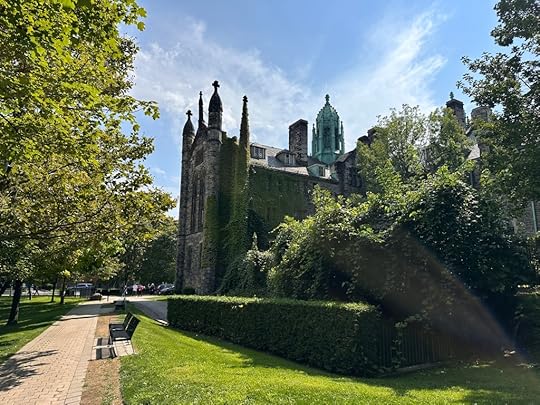


I was delighted to learn that Jalaluddin’s most memorable childhood reading experience was of reading Anne of the Island when she was “maybe 10 years old and home sick with the flu. I lay on the couch and devoured that book,” she says, “only realizing when I was done that it was the third in a series! L.M. Montgomery is now one of my all-time favourite authors.” Most readers encounter Anne of Green Gables first, and then go on to explore the later books in the series; I don’t know if I’ve come across other examples of readers who’ve discovered Anne as an older character first. I’m now trying to imagine what it would be like to meet Anne for the first time as a student at Redmond College, instead of as an eleven-year-old “girl—a strange girl—an orphan girl” at the Bright River train station.
I loved Much Ado About Nada as much as (or possibly even more than) Jalaluddin’s Ayesha at Last (which I wrote about in a blog post earlier this year), and I’m now keen to read Hana Khan Carries On. I found myself completely caught up in the richly detailed fictional world she created, eager to find out what would happen next for Nada and the other characters. Jalaluddin’s newest book, co-authored with Marissa Stapley, is Three Holidays and a Wedding.
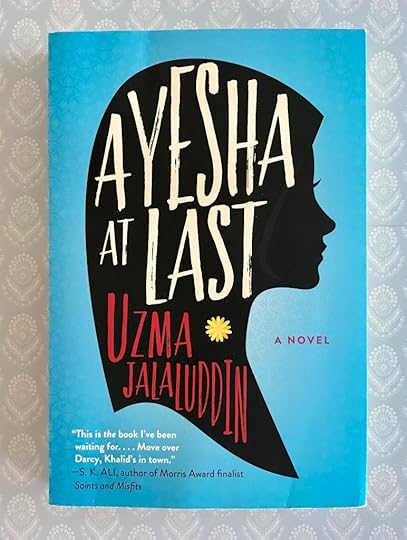
Since I’ve been talking about the University of Toronto in this post, I also want to share a link to this essay on “The Novel and the Museum,” by Kerry Clare, whose most recent novel is Asking for a Friend. She describes the view of the Royal Ontario Museum from the residence she lived in when she was a student at the University of Toronto in the late 1990s. “Every night,” she says, the sun went down behind the museum, “a little earlier than it might have if we’d had a less magnificent neighbour.”
My daughter and I visited the Royal Ontario Museum in August:


Kerry writes that “It’s a weird thing to raise your children around the same neighbourhoods where you spent your formative—and perhaps most nonsensical years, to push a stroller along that very same block where I once worked at Pizza Hut, all brand new condos now.” Although she didn’t visit the museum when she was a student, she has a membership now and she takes her children there to explore “hands-on galleries and dinosaur bones.” Walking or driving on the same streets twenty-five years later, she wonders, “am I haunting the places I used to know or are the places haunting me?”
I sometimes wonder the same thing, as I now live in the neighbourhood where I grew up, near my old school, and the church where I was baptized, and a different church where I went to Brownies and Girl Guides. If I were living further away, would I think of scenes from my childhood as often as I do? Every time I pass my old school, for example, I can see myself in the schoolyard when I was seven years old, and at the same time, I can also see the students from my grade nine class, lined up on the steps at the front entrance for our graduation portrait. I can feel the satin and lace of the dress I wore that day, which had belonged to my grandmother in the 1940s, and which my mother had altered so it would fit me. We dyed it, aiming for a deep navy, but it ended up being more like periwinkle blue. (It has since faded, and is now a shade of lavender.) How often would I think of that portrait and those friends and classmates and that dress, I wonder, or the graduation dance in the church basement across the street from the school, if we hadn’t left Boston to move back home to Halifax?
Kerry quotes Virginia Woolf on “the masculine values that prevail”: “This is an important book, the critic assumes, because it deals with war. This is an insignificant book because it deals with the feelings of women in a drawing-room. A scene in a battle-field is more important than a scene in a shop—everywhere and much more subtly the difference of value persists” (A Room of One’s Own). In Asking for a Friend, Kerry writes about women’s friendships, and the questions of “What lasts? What survives?” “Women’s stories matter,” she says, “but for too long such stories have been lost to history, absent from the archives, missing from the museum.” “The feelings of women in a drawing room,” Kerry says again—“that’s a book I want to read, and this is the book I wanted to write.”
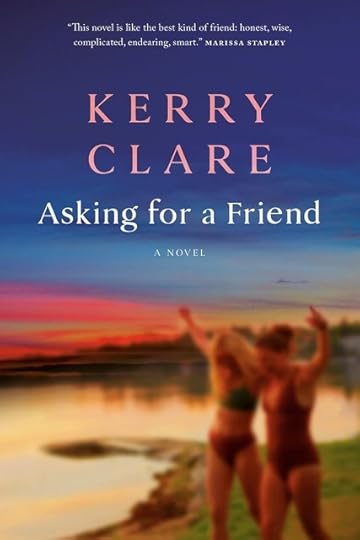
There are a few more things I want to share with you this week. First, some of you might be interested in a special online panel discussion about Emily Carr, Jane Austen, and L.M. Montgomery, on December 13th. It’s called “House to House,” and you can register on the Emily Carr House website.
Last week, when I wrote about birthday “coincidences,” I hadn’t realized that Carr’s birthday (Dec. 13th) is so close to Montgomery’s (Nov. 30th) and Austen’s (Dec. 16th).
My friend Kate Scarth, Chair of L.M. Montgomery Studies at the University of Prince Edward Island, told me a few days ago about the new Anne of Green Gables audiobook directed by Megan Follows, who played Anne in the 1995 miniseries adaptation of the novel. Follows says she spoke with the cast about how Anne was revolutionary—“to have an imagination, to have feeling, to express feelings, and for girls to express anger.”
Next, some photos I took recently near Windsor, Nova Scotia:



Last Friday, I asked if you have favourite notebooks, and when my friend Sheila Kindred came over for tea that afternoon, she brought her current notebook to show me. I took a picture of it with the gorgeous William Morris tea towel she and her husband Hugh gave us as a housewarming present. She uses the notebook as a place to record ideas, as well as upcoming events and appointments.
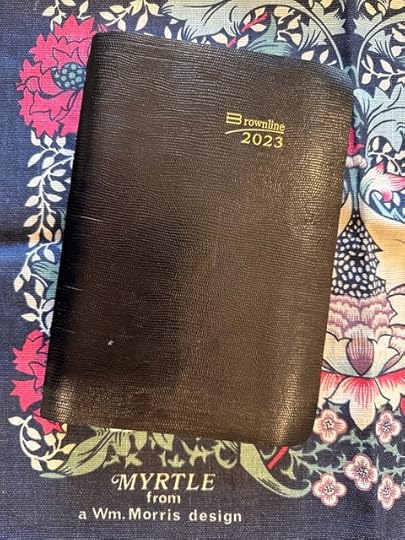
As many of you will know, Sheila is the author of a biography of Jane Austen’s sister-in-law, Fanny Palmer Austen, entitled Jane Austen’s Transatlantic Sister. She recently published two blog posts about Charles Austen (Jane’s brother and Fanny’s husband): one on the Naval General Service Medal that he received in 1849 and one on a ceremonial sword that was presented to him by General Simon Bolivar.
If you enjoyed the passage from Toni Morrison about her note-taking habits that I quoted last week, you might also like to read Jillian Hess’s follow-up post about Morrison’s research notes for Beloved. Hess says that “In an early synopsis of Beloved, Morrison imagined she’d write three novels, each called ‘Beloved,’ but with different subtitles. The trilogy would feature Beloved at different moments in history. Ultimately, Morrison decided only to write the first.”
Continuing on from last week’s theme of book recommendations for holiday gift-giving, I thought you might be interested (if you haven’t seen it yet) in this 2022 New York Times article by Jennifer Harlan about “How a Good Book Became the ‘Richest’ of Holiday Gifts.” She quotes a passage from 1933 that seems directly relevant to 2023: “‘There could be no better year than this to give books for Christmas,’ The Times reported in 1933, in the midst of the Great Depression. ‘In a world tumultuous with changes and alarms the realm of reading has values that are more than ever appealing.’”
This passage made me think of a quotation I saw recently on a tote bag from Square Books in Mississippi:
And don’t fight when you’re angry.
Think when you’re angry.
Write when you’re angry.
READ when you’re angry.
– Kiese Laymon

Since I live inside the language of Pride and Prejudice, I also hear Mr. Darcy saying, “I cannot comprehend the neglect of a family library in such days as these.”
I’ll end with some photos my sister Edie took last weekend, when she was in San Francisco and Sacramento (where she ran the California International Marathon; our parents were there to cheer her on in person and the rest of the family cheered from a distance: “Go Speedy Edie!!”):


If you enjoyed this post, I hope you’ll consider recommending it to a friend. I’m always interested to read your comments and messages. Thanks for reading!
December 1, 2023
“The children are a world unto themselves”
Happy December to all of you! I’d love to hear what you’re reading these days. I’m always looking for recommendations even though I’ll never be able to keep up with all the books I want to read. After years of keeping track of books I want to read in a list on my computer, I’ve decided to start recording new recommendations in a notebook that was handmade (years ago) by my friend Maggie.
I’ve added the books by Ursula K. Le Guin that some of you recommended to me a few weeks ago, along with some books my friend Naomi wrote about in a recent blog post (including The List of Last Chances, by Christina Myers, and The Adversary, by Michael Crummey), The Lonely Hearts Book Club, by Lucy Gilmore (recommended by my friend and fellow L.M. Montgomery fan Nili because Anne of Green Gables features prominently), and many other titles.
What books would you like to receive over the holidays? What books are you thinking of giving as presents?
As I’ve said here before, I’m not in the habit of making lists of the best books I read each year, but since I did name one book in 2022 (Animal Person, by Alexander MacLeod), I’ll name one top favourite for this year: The Little Books of the Little Brontës, brilliantly written by Sara O’Leary and beautifully illustrated by Briony May Smith, in which the Brontë children are “a world unto themselves.”

“The books they write are tiny, but the worlds inside them are huge.”
My book recommendations notebook:

I’m reading After Anne: A Novel of Lucy Maud Montgomery’s Life, by Logan Steiner, which focuses on Montgomery’s thirty-third birthday, at a time when she was engaged and had received news that the manuscript of Anne of Green Gables had been accepted for publication. This birthday, she knows, will feel very different from her birthdays in recent years, when there had been no manuscript and no publisher. Not even a completed manuscript.” In the past, “accompanying the sting of each of those birthdays was the old sinking feeling that would start up in her chest come November. Her habitual winter blues. Not that anyone would have known it about her. To nearly everyone, she was a ‘very jolly girl,’ ‘always in good spirits,’ no matter the season.”
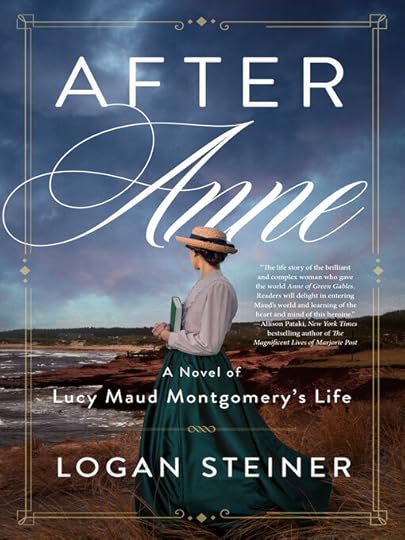
I’m also interested in The Grace of Wild Things, a middle-grade novel by Heather Fawcett, inspired by Anne of Green Gables (and recommended by my friend Lisa). The heroine, Grace, asks, “Do you think one can have too much imagination? It seems to me it’s rather like having too much lemon shortbread or too many flowers in your garden. After all, if you had too little imagination, you’d spend your life finding fault with everything….”

My friend Hughena Matheson published a piece in The Hamilton Spectator yesterday with a list of book recommendations for children, including Lawrence Hill’s Beatrice and Croc Harry. Hill says he hopes the novel will speak “to children and adults of all ages who love language and who welcome story as one of humankind’s greatest gifts.”
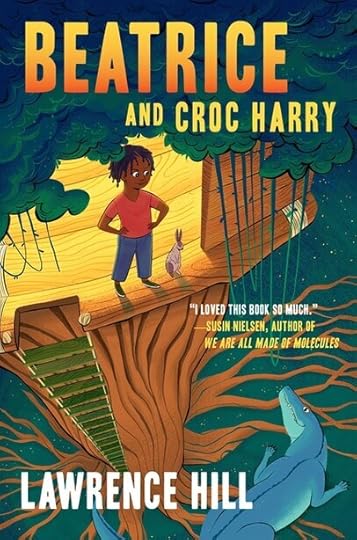
A recent article on Robert McCloskey’s picture books sent me back to reread some old favourites: Blueberries for Sal, One Morning in Maine, and Time of Wonder. In “Robert McCloskey’s Maine Trilogy as an Antidote to Climate Change Despair,” Ethan Warren quotes Gary D. Schmidt, who says that in “a world that chose to war with itself,” McCloskey provided an “absolute affirmation of the permanence and beauty and significance of the world.”
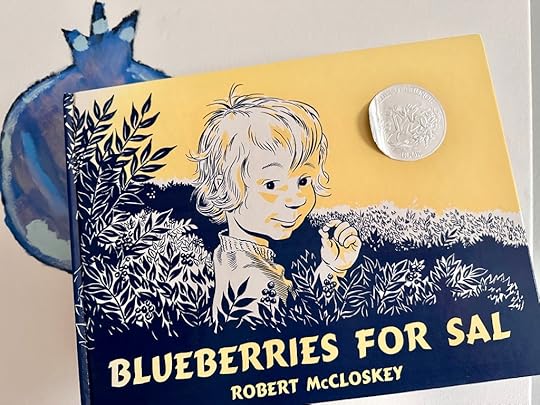
I took a picture of my daughter’s copy of Blueberries for Sal next to her painting of an enormous blueberry, which hangs on the wall in my office.
I’m looking forward to reading Juliette Wells’s new book A New Jane Austen: How Americans Brought Us the World’s Greatest Novelist, and I enjoyed reading this excerpt, “How American Critics Originated Jane Austen Scholarship.” Juliette writes of Oscar Fay Adams, who “encouraged and equipped a new generation of readers, including but not limited to Americans, to cultivate their own appreciation of Austen’s works. Thus Adams stands too as the founder of what we would now call public humanities writing on Austen. All these extraordinary contributions he made with the credential only of his teaching degree, and without any academic affiliation at all.”

I’m keen to read two books by friends from the University of Alberta:
Relating Carol Shields’s Essays and Fiction: Crossing Borders, edited by Nora Foster Stovel,

and Apples on the Windowsill, by Shawna Lemay, “a series of meditations on still life, photography, beauty, and marriage.” You might remember my blog post about her fabulous novel Everything Affects Everyone, which I wrote about back in March.

Yesterday on her blog, Transactions with Beauty, Shawna recommended Lisa Whittington-Hill’s new book, Girls Interrupted: How Pop Culture is Failing Women, and I’ve added that to my book recommendations notebook as well. Whittington-Hill says it sometimes seems “that things are now better for women in Hollywood, in publishing, and in the music industry. That the problems have been fixed, that we can pat ourselves on the back for a job well done and move on. This book exists to prove otherwise.” Shawna writes that the book “will be the one I press upon a few friends, with ‘you HAVE to read this.’”

Here are a couple of L.M. Montgomery-related things I’d like to share with you. My friend Kate Scarth is the editor of the Journal of L.M. Montgomery Studies (and the author of guest posts for my blog on Jane Austen’s Emma—“Highbury Heights; or, George and Emma Knightley, Suburban Developers”—and Northanger Abbey—“‘Miss Morland; do but look at my horse’: Horses’ John Thorpe Problem”), and she wrote recently to share the exciting news about a special collection called “Writers and Artists Respond to L.M. Montgomery,” to be published in the Journal starting in November 2024, in honour of the 150th anniversary of Montgomery’s birth.
The call for submissions says “We encourage contributors to explore a wide range of Montgomery’s works—her adult novels, the Emily series, short stories, non-fiction, scrapbooks, photos, any of the Anne books, aspects of her biography. The work may be analytical, critical, personal, approving, disapproving—but it must come from artists. We seek responses from as many points of view, cultures, countries, backgrounds, and identities as possible. Montgomery’s appeal has been deep, enduring, and widely international. This special anniversary collection aims to reflect that.” More details are available here.

Yesterday, on the 149th anniversary of Montgomery’s birth, Benjamin Lefebvre published an essay by LMM that as far as he knows hasn’t been reprinted since its first appearance in February 1939, in the Dalhousie Gazette. It’s called “An Author Speaks,” and if you’re interested, you can find the full text at L.M. Montgomery Online. I like the advice Montgomery gives to writers: “Before attempting to write a book be sure you have something to say. It need not be a very great or lofty or profound something. … But if we have something to say that will bring a whiff of fragrance to a tired soul or a weary heart, or a glint of sunshine to a clouded life, then that something is worth saying and it is our duty to try to say it as well as in us lies.”

I also want to recommend this piece by Jillian Hess about “Creative People and Their Notebooks,” from her Substack newsletter, Noted. As a gift idea, she suggests the same kind of notebook the person’s favourite author, artist, or musician used. Octavia E. Butler, for example, used Mead’s Five-Star notebooks, and Toni Morrison used yellow legal pads.
I like what Morrison says about catching ideas before they disappear: “I have so many things to do: I have to get it down someplace so that I can refresh my memory about certain things, not about the overall work I’m doing, but about the details which could slide by me and slip away.”
Please do write and tell me what you’re reading, or looking forward to reading next. (And/or tell me about your favourite notebooks!)
Here’s the last flower from my mother’s garden, still thriving in late November:
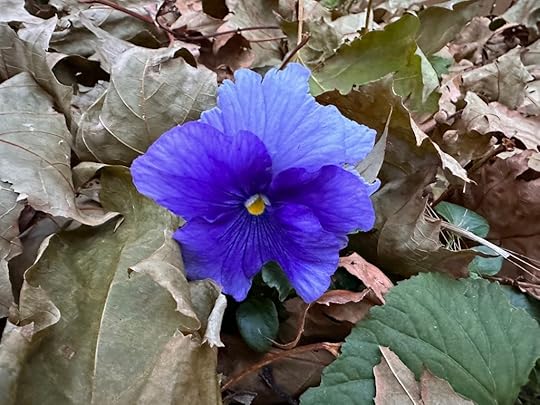
And here are some recent photos from a visit to the look-off at Herring Cove Provincial Park:



And photos by Brenda Barry, sent to me by her sister Sandra: some “amazing leafy lichen,” ice on the Mersey River Trail, “a luminous leaf at the Historic Gardens” in Annapolis Royal, and “a lovely female American Black Duck resting on the pond at the French Basin Trail.”




If you enjoyed this post, I hope you’ll consider recommending it to a friend. I’m always interested to read your comments and messages. Thanks for reading!
November 30, 2023
“A very strange coincidence”
L.M. Montgomery was born 149 years ago today, on November 30, 1874, in Clifton (now New London), Prince Edward Island. My favourite quotation about birthdays in her novels appears in Anne of Green Gables: just after Anne has met Diana Barry for the first time, and the two of them have sworn to be faithful friends “as long as the sun and moon shall endure,” Anne tells Marilla all about their meeting and her happiness, and one of the things that delights her about her new friendship is that “Diana’s birthday is in February and mine is in March. Don’t you think that is a very strange coincidence?”
Isn’t that lovely? I wrote about this “coincidence” in a blog post a few years ago: “Birthday Coincidences in Emma and Anne of Green Gables.”
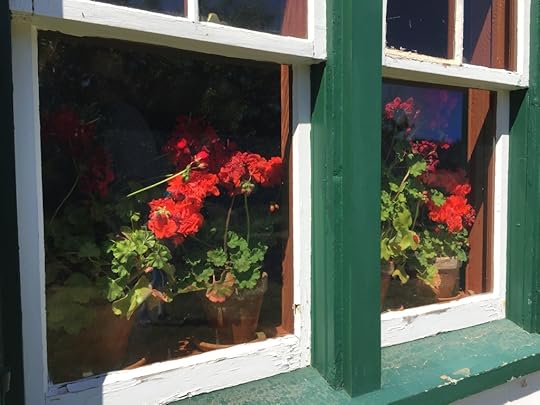
Geraniums in the window at Green Gables
Next year, 2024, will be the 150th anniversary of Montgomery’s birth. The year after that, 2025, will be the 250th anniversary of Jane Austen’s birth. A strange coincidence, don’t you think?
Well, whether it’s a coincidence or not, I’m looking forward to celebrating both occasions. Do any of you have plans for these upcoming anniversaries? I have a few ideas for both. And if you have suggestions, I’d love to hear them….
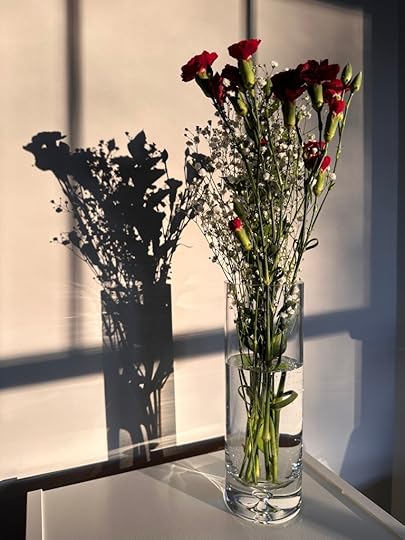
These pretty red carnations were a housewarming present from my friend Jill MacLean the other day. (Jill wrote a guest post here last March, about Claire Keegan’s Small Things Like These and Sarah Moss’s books Summerwater and Names for the Sea.) The colour made me think of the Story Girl: “I’d never get tired of red. … I just love it—it’s so rich and glowing.”
P.S. Jane Austen’s House Museum is hosting a virtual birthday party again this year, for Austen’s 248th birthday on December 16th, with music, readings, and games “in the spirit of Jane Austen and her family.” Tickets are available on the museum’s website.
If you enjoyed this post, I hope you’ll consider recommending it to a friend. I’m always interested to read your comments and messages. Thanks for reading!
November 24, 2023
“I always supposed everyone thought in colours” #ReadingStoryGirl
Cecily is “a sweet pink,” like a mayflower, Sara Ray is “very pale blue,” Dan is red, Peter and Felix are yellow, and “Bev is striped”—and “you needn’t laugh,” says the Story Girl in L.M. Montgomery’s novel The Golden Road, because “It isn’t he that is striped. It’s just the thought of him.” Felicity has never heard of synesthesia—(not that the Story Girl uses that term when she describes the link between thoughts and colours) and she doesn’t believe it exists: “I believe you are just making that up,” she says (Chapter 12).
“Indeed I’m not,” replies the Story Girl. “Why, I always supposed everyone thought in colours. It must be very tiresome if you don’t.” She says, “There are times when I can’t think anything but grey thoughts. Then, other days, I think pink and blue and gold and purple and rainbow thoughts all the time.”

(This is part four in a series of posts about The Story Girl and The Golden Road. Naomi MacKinnon and I are hosting a readalong this month and we’re delighted to have your company! We hope you’ll join the conversation in the comments on her blog and mine, and if you write your own posts about the novel online, please share the links with us. Here are the links to my first, second, and third posts in the series, and to Naomi’s post on The Story Girl.)

I thought of the Story Girl’s words about colours again a little later in the novel, when Montgomery describes the beauties of the landscape in Prince Edward Island in June. In this passage, she doesn’t mention colours aside from that of the metaphorical golden road, and yet even so, I find her writing brings the scene to life in full colour.
“Cecily declared she hated to go to sleep for fear she might miss something. There were so many dear delights along the golden road to give us pleasure—the earth dappled with new blossom, the dance of shadows in the fields, the rustling, rain-wet ways of the woods, the faint fragrance in the meadow lanes, liltings of birds and croon of bees in the old orchard, wind pipings on the hills, sunset behind the pines, limpid dews filling primrose cups, crescent moons through darkling boughs, soft nights alight with blinking stars” (Chapter 15).
I can see the rich red soil of PEI, the green fields and forests, pale blue forget-me-nots in Lovers’ Lane, and bees and sunsets and primroses (and wild roses, too) and bright stars against the dark sky.

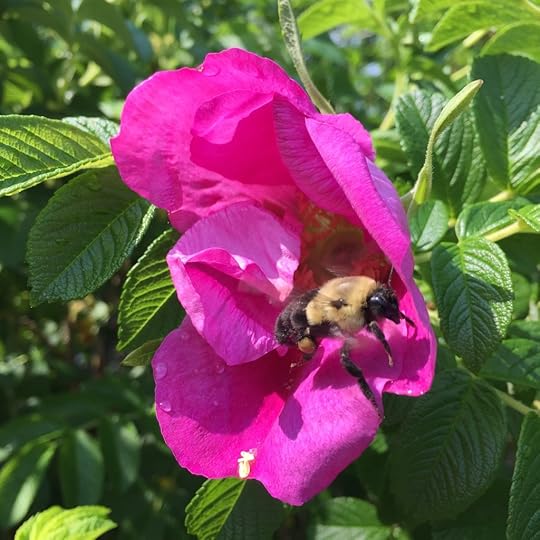


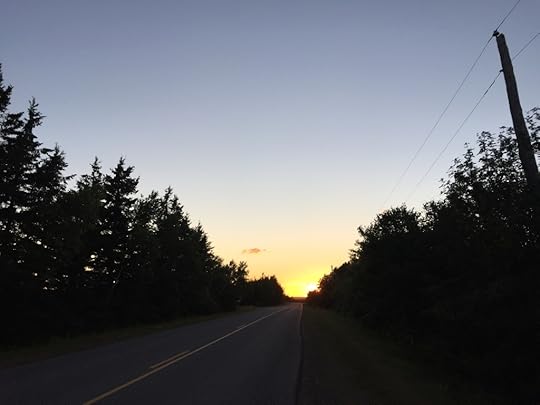
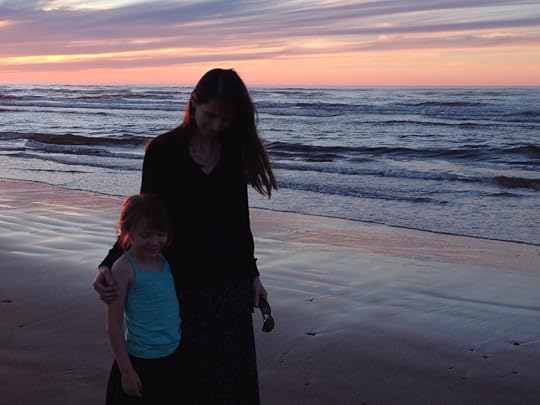
My daughter and me at Stanhope Beach, PEI, on an evening in June several years ago
Like Anne Shirley, and like L.M. Montgomery herself, the Story Girl loves springtime. “I wonder what it would be like to live in a world where it was always June,” Anne muses in Anne of the Island.
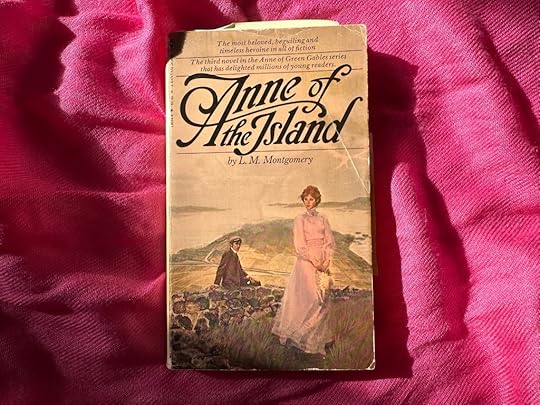
“What would it be like to live in a world where it is always June?” Montgomery had written in a journal entry at the end of June in 1902, thirteen years before Anne of the Island was published. She had been for a walk in Lovers’ Lane, where she felt grateful for the healing effects of nature. “Somewhere in me the soul of me rose up and said, ‘No matter for those troubles and problems that looked so big and black in the night. They are mortal and will pass. I am immortal and will remain.’”
“It’s so nice to be alive in the spring,” the Story Girl says one evening at twilight as the children “swung on the boughs of Uncle Stephen’s walk” (Chapter 10). Felicity responds, “complacently,” that “It’s nice to be alive any time,” and the Story Girl insists, “But it’s nicer in the spring.” She speaks of the soul that Montgomery sees as immortal: “When I’m dead,” says the Story Girl, “I think I’ll feel dead all the rest of the year, but when spring comes I’m sure I’ll feel like getting up and being alive again.”

In The Golden Road, the children must face the death of the beloved cat Paddy, and they plan a proper funeral “since Paddy was no common cat,” and “Many human beings have gone to their graves unattended by as much real regret as followed that one grey pussy cat to his” (Chapter 29). We don’t see the deaths of any of the children themselves, but we do learn from Bev that although most of them will go on to lead long lives, “there was no earthly future for our sweet Cecily” (Chapter 30). The Story Girl tells fortunes for all the others, giving details about careers and marriages and even about changes in political allegiances—“Catch me ever voting Grit!” objects Dan when he hears his fortune—but she at first refuses to tell Cecily’s. Eventually, she offers that “Everybody you meet will love you as long as you live,” and Bev wonders if the Story Girl had “some strange gleam of foreknowledge” that Cecily would never “leave the golden road” of youth.

I enjoyed reading the Story Girl’s remarks about storytelling. “I am not telling you what Ursula Townley ought to have done,” she says to her audience at one point. “I am only telling you what she did do. If you don’t want to hear it you needn’t listen, of course. There wouldn’t be many stories to tell if nobody ever did anything she shouldn’t do” (Chapter 2).
Another example: “‘I shall try not to be vexed when people interrupt me when I’m telling stories,’ wrote the Story Girl, ‘but it will be hard,’ she added with a sigh” (Chapter 4). As I mentioned in last week’s post, during the writing of The Golden Road Montgomery was “all the time nervously expecting some interruption—which all too surely came nine times out of ten. Under such circumstances there is very little pleasure in writing.” She wrote in her journal that she often thought of the time she had spent writing in her old room at her grandparents’ house in PEI, “But those days are gone and cannot return as long as wee Chester [her son] is a small make-trouble. I do not wish them back—but I would like some undisturbed hours for writing” (May 21, 1913).

When Paddy is missing, the Story Girl says she can’t bear the uncertainty of not knowing: “If I just knew what had happened to him it wouldn’t be quite so hard” (Chapter 10). Later in the novel, however, when Sara Ray says she “hates things with mysteries” because “They always make me nervous,” the Story Girl says, “I love them. They’re so exciting” (Chapter 24). In this case, they’re discussing the mysterious locked room in the Awkward Man’s house. Years later, Sara Stanley sends Bev the story of the romance between Jasper Dale and Alice Reade.
I don’t remember if I found this story romantic when I read it as a child. This time around, I found it unnerving. Jasper Dale “shadowed forth to himself the vision of a woman, loving and beloved; he cherished it until it became almost as real to him as his own personality and he gave this dream woman the name he liked best—Alice” (Chapter 25). He doesn’t just dream of her, he buys a portrait that resembles her, sets up a secret room in his house for her, buys books he thinks she’d like, along with a sewing basket and “a pale blue tea-gown” and satin slippers, and keeps the room “sweet with fresh flowers.” In the “purple summer evenings” he sits in the room and talks to her or reads from his favourite books. (Isn’t it interesting that although he’s chosen books with this imaginary woman’s taste in mind, when he reads aloud to her, he chooses his own favourites?) I thought of Barney Snaith in Montgomery’s novel The Blue Castle, who also keeps a secret (fiction) in a locked room.
It seems as if Jasper Dale is dreaming of the woman he hopes to meet someday. But the Story Girl says clearly that in imagining her, “he turned to this ideal kingdom for all he believed the real world could never give him.” One friend who’s reading The Golden Road with us this month told me she wondered if he was furnishing the room and buying the dress and slippers not for “Alice” but for himself—for a version of himself that he couldn’t share with others in that particular time and place. What do you think?
When Alice Reade comes to teach music in Carlisle and Jasper Dale catches sight of her, he believes “his dream love had taken visible form before him.” Instead of taking bouquets into the secret room, he begins to leave flowers under the pine tree, where the real Alice will find them, and one day, Miss Reade overhears him confessing his love for her and his wish that she will someday be his wife. She responds instantly with a confession of her own love for him, and the story ends with him kissing her.
The Story Girl says “Miss Reade is perfectly happy” at the prospect of getting married (Chapter 24). But I share Felicity’s skepticism: “All I can make out is that Miss Reade is going to marry Jasper Dale, and I don’t like the idea one bit.” We know very little about her, or her dreams and ambitions: she seems to have appeared simply as the embodiment of Jasper Dale’s vision. Like the “one face” that “looks out from all his canvases” in Christina Rossetti’s poem “In an Artist’s Studio,” Alice Reade is “A saint, an angel—every canvas means / The same one meaning, neither more nor less.” Jasper Dale, like the artist, “feeds upon her face by day and night, / And she with true kind eyes looks back on him.”
“I loved you long before I saw you,” Jasper says to his Alice after she has confessed her love. I can’t help but think, however, that like the artist in Rossetti’s poem, he loves her “Not as she is, but as she fills his dream.”
There’s so much more I could say about this novel, but I’ve already written at length, so I think I’ll stop here. Please feel free to chime in about other topics in the comments—Peg Bowen, for example, or the three absent fathers who all return near the end of the novel. It’s been a real pleasure to reread and write about The Story Girl and The Golden Road this month, and I’m grateful to everyone who’s joined us.
L.M. Montgomery’s birthday is coming up on Thursday, November 30th, and I’ll be back with an extra post that day. In early December, I think I’ll write about some Jane Austen-inspired novels, and then I’ll turn to LMM again, with a post on Emily of New Moon, in honour of the novel’s 100th birthday.
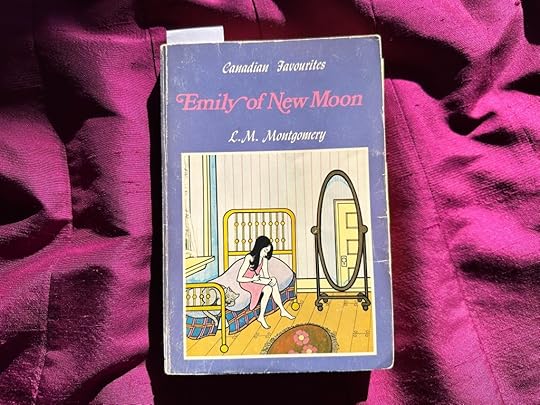
On a different topic, I want to add a note here about a book launch this evening, for The Broadview Anthology of Medieval Arthurian Literature, edited by my friends Kathy Cawsey (who wrote a guest post on L.M. Montgomery’s Jane of Lantern Hill for my blog in the spring) and Elizabeth Edwards. Here’s what Michael W. Twomey of Ithaca College says about the book: “Going beyond the canonical Latin, French, and English texts that established the characters and narratives collected in Thomas Malory’s Morte Darthur, BAMAL adds texts from Welsh, Hebrew, Norse, Dutch, German, and Greek, plus a collection of visual images, all of which make it a unique collection. More than any previous anthology, BAMAL shows the diversity and vitality of medieval Arthurian literature.”
The launch is at the King’s College Library in Halifax, Nova Scotia, tonight at 7pm. Congrats, Kathy and Elizabeth!

Previous posts about The Story Girl and/or The Golden Road
On my blog:
An Invitation to Read The Story Girl and The Golden Road
An Necklace of Expressive Words
“The best piece of work I have yet done” #ReadingStoryGirl
“This old blue chest holds a tragedy” #ReadingStoryGirl
“The Golden Road of Youth” #ReadingStoryGirl
On Naomi’s blog, Consumed By Ink:
The Story Girl Readalong #ReadingStoryGirl
#ReadingStoryGirl: “There is such a place as fairyland—but only children can find the way to it…”
On Buried in Print:
November 2023, In My Bookbag (also, L.M. Montgomery)
If you enjoyed this post, I hope you’ll consider recommending it to a friend. I’m always interested to read your comments and messages. Thanks for reading!
Arriving in PEI on the ferry on a warm June day:

PEI lupines, on the day of the unveiling of the L.M. Montgomery Project Bookmark Canada plaque in Cavendish (June 24, 2018):


November 17, 2023
“The Golden Road of Youth” #ReadingStoryGirl
Like Anne of Green Gables, Sara Stanley—the Story Girl—is drawn to roads, with their twists and turns and the mysteries of where they will lead us. Anne Shirley famously speaks of “the bend in the road” in the last chapter of Anne of Green Gables, and of her fascination with how “the road beyond it goes—what there is of green glory and soft, checkered light and shadows—what new landscapes—what new beauties—what curves and hills and valleys further on” (Chapter 38). The Story Girl begins with Sara Stanley’s announcement that “I do like a road, because you can be always wondering what is at the end of it.”
In The Golden Road, L.M. Montgomery continues the story of the Story Girl and her band of friends, and makes clear in the foreword to the novel that in this case, the road is not one that leads into the future. Instead it is “the golden road of youth” that we all walked on, “once upon a time.” It’s a road we leave behind, yet Montgomery suggests that we can still find our way to that world through memory, and through stories.

(This is part three in a series of posts about The Story Girl and The Golden Road. Naomi MacKinnon and I are hosting a readalong this month and we’re delighted to have your company! We hope you’ll join the conversation in the comments on her blog and mine, and if you write your own posts about the novel online, please share the links with us. Here are the links to my first and second posts in the series.)
I experienced some trepidation when I started rereading The Golden Road, because I remembered the scene in The Story Girl in which Sara Stanley chastises Sara Ray for wanting to know what happens after the ending of a story. “You’re never satisfied to leave a story where it should stop, Sara Ray,” she says (Chapter 21). Should the story of The Story Girl and her companions have stopped at the end of that novel? Or was there enough material to warrant a sequel? These questions made me wonder the same thing about the “Anne” books. I wonder what Montgomery might have written if she hadn’t felt such tremendous pressure to keep writing sequels, and to write them quickly.

I liked the elegiac tone of the ending of The Story Girl, with its lament for the beautiful summer that has ended, and its celebration of “the pleasure of bird song, of silver rain on greening fields, of storm among the trees, of blossoming meadows.” But when I opened The Golden Road and read the Foreword (by Montgomery herself? or is this in Bev’s voice?), I found the tone almost unbearably sentimental. “Life was a rose-lipped comrade with purple flowers dripping from her fingers” is just one example of the excesses here.
I enjoyed reading about what was happening in Montgomery’s life while she was composing The Golden Road. In fact, I discovered that I enjoyed reading about the context more than I enjoyed reading these two novels. Just as I did earlier this month when I was reading The Story Girl, I turned to Elizabeth Waterston’s Magic Island: The Fictions of L.M. Montgomery, Mary Henley Rubio’s biography, Lucy Maud Montgomery: The Gift of Wings, and Montgomery’s journals, edited by Waterston and Rubio.
There’s a huge contrast between what was happening in Montgomery’s life during the composition of The Story Girl and during the composition of The Golden Road. When she wrote the former, she was preparing to leave PEI. By the time she began the latter on April 30, 1912 she had, in Waterston’s words, “entered her own ‘sequel’”: she had “left the idyllic isle and moved to the Upper Canada village life of Leaskdale.” She had married Reverend Ewan Macdonald in July of 1911, they had moved to Ontario, and soon she was expecting her first child. The book she published in between The Story Girl and The Golden Road, a collection of stories called Chronicles of Avonlea, appeared in print in June, 1912.
Although Montgomery felt she had made a mistake in marrying Ewan—she described her wedding day as a time when “I was as unhappy as I had ever been in my life” (January 28, 1912)—she delighted in the birth of her son Chester. He was born in July of 1912, and at the end of the year she wrote in her journal that this had been “the greatest year of my life—the year that brought me motherhood. I faced death in it, and came off conqueror.” She said it had been her “annus mirabilis—the wonderful year” (December 31, 1912)—a stark change from the misery she had felt when she was writing The Story Girl.
The Story Girl had been a source of joy during a difficult time. Now, during a time when she was experiencing a fair amount of happiness, on the day she finished writing The Golden Road, she wrote that “I have not enjoyed writing it. I have been too hurried and stinted for time. I have had to write it at high pressure, all the time nervously expecting some interruption—which all too surely came nine times out of ten. Under such circumstances there is very little pleasure in writing” (May 21, 1913).
The novel was published on September 1st of that year, and on that same day she started to work on a third book about Anne. “I did not want to do it,” she recorded later in September. “But Page [her publisher] gave me no peace and every week brought a letter from some reader pleading for ‘another Anne book.’ So I have yielded for peace sake. It’s like marrying a man to get rid of him!” (September 27, 1913).
The new book was, of course, Anne of the Island.

What did you think of Bev’s idea in The Golden Road to launch a newspaper? As a fan of Montgomery’s scrapbooks (and a creator of scrapbook-inspired blog posts), I like his suggestion that “We can put anything we like in the scrapbook department.”
What did you think of the New Year’s resolutions the children make? I’m fond of the Story Girl’s resolution: “I will have all the good times I can.”
I’ve collected some “golden” photos for you. First, since I said about a month ago that I’d take some pictures when the birches turn “golden as sunshine” (borrowing Montgomery’s phrase from Anne of Green Gables), here’s the birch tree in our backyard:

I found a field of golden sunflowers when my family and I visited PEI last year:

And here’s a golden field of mustard, photographed by Brenda Barry in the Annapolis Valley in Nova Scotia:

I’ll write more about The Golden Road next week. Naomi and I are talking about another LMM readalong in the spring, for Kilmeny of the Orchard. In the meantime, I’m thinking of rereading Emily of New Moon before the end of the year, because 2023 is the novel’s 100th anniversary. Do any of you want to join me? I’ll plan to write at least one post about it sometime in December.
Elizabeth Egan wrote recently in the New York Times that Montgomery’s Emily “was forged in a time of uncertainty, one similar to our own” and proposed that “At 100 years old, she deserves a spotlight of her own.” I agree, and I’m looking forward to revisiting this novel, one of my old favourites.
Previous posts about The Story Girl and/or The Golden Road
On my blog:
An Invitation to Read The Story Girl and The Golden Road
An Necklace of Expressive Words
“The best piece of work I have yet done” #ReadingStoryGirl
“This old blue chest holds a tragedy” #ReadingStoryGirl
On Naomi’s blog, Consumed By Ink:
The Story Girl Readalong #ReadingStoryGirl
On Buried in Print:
November 2023, In My Bookbag (also, L.M. Montgomery)
If you enjoyed this post, I hope you’ll consider recommending it to a friend. I’m always interested to read your comments and messages. Thanks for reading!
November 10, 2023
“This old blue chest holds a tragedy” #ReadingStoryGirl
Of all the stories told by Sara Stanley in The Story Girl, the one I remembered most vividly from my first reading of the novel is “The Blue Chest of Rachel Ward” (Chapter 12), the sad story of Sara’s grandmother’s cousin Rachel and the day that was supposed to be her wedding day. Sara tells Bev and the other children about how Rachel, an orphan from Montreal, came to spend a winter with relatives in Prince Edward Island, fell in love with handsome Will Montague—“an awful flirt,” according to Felicity—and got engaged. Over the winter she “made all her wedding things with her own hands,” but when the day of the wedding arrived, “Will Montague never came!”

(This is part two in a series of posts about The Story Girl and The Golden Road, by L.M. Montgomery. Naomi MacKinnon and I are hosting a readalong this month and we’re delighted to have your company! We hope you’ll join the conversation in the comments on her blog and mine, and if you write your own posts about the novel online, please share the links with us.)
Instead of wearing her wedding dress forever, as Charles Dickens’s Miss Havisham does in Great Expectations after she is jilted at the altar, Rachel Ward packed away the dress and all her linens and presents in an old blue chest and left for Montreal, taking the key with her. The Story Girl says, “This old blue chest holds a tragedy,” and for Bev and his brother Felix it takes on “a new significance,” as it seems “like a tomb wherein lay buried some dead romance of the vanished years.”
I took this photo of the blue chest, Montgomery’s source of inspiration for this story, at the Anne of Green Gables Museum in Park Corner, PEI last year:

Elizabeth Waterston writes in Magic Island: The Fictions of L.M. Montgomery that by writing “this complex, ambiguous novel, Montgomery had opened her own version of the blue chest” by celebrating “her memories, passions, and experiences, but also her own ambition and her own accomplishments, her books and life documents.” I found it curious, though, that Waterston doesn’t comment here on the significance of the story of the blue chest in relation to the fact that while she was writing The Story Girl,Montgomery was preparing for her own wedding day.
Near the end of the novel, the family receives news from Montreal that Rachel Ward has died, leaving instructions for the opening of the chest. Although the children get to see its contents at last, the private story of the dead romance will be lost forever, because Aunt Olivia declares that Will Montague’s letters must be “burned unread,” along with the wedding dress. Instead of a more detailed story, the children are each given an item from Rachel’s chest “to remember her by”: a blue candlestick for the Story Girl, two pink and gold vases for Felicity and Cecily, handkerchiefs for the boys, and a china plate for Sara Ray, which she plans to display on the parlour mantlepiece.
I enjoyed both Felicity’s objection that she doesn’t see “much use in having a plate just for ornament” and Sara’s insistence that “it’s nice to have something interesting to look at.” Felicity herself also likes pretty china—her rosebud plate is mentioned more than once—but she likes for it to be useful. The rosebud plate is used as a collection plate when Bev gives his first sermon, and then when Peter is recovering from the measles, she offers to lend him the rosebud plate “to eat off of. I’m only lending it, you know, not giving it. I let very few people use it because it is my greatest treasure” (Chapter 30).

The instructions from Rachel Ward, from beyond the grave, about what she wants done with her belongings made me think of “Once Removed,” a short story by Alexander MacLeod that was published in the New Yorker a couple of years ago and is included in his collection Animal Person: “Amy thought about the afterlife of objects. All the things that were still here and the people who were not.” And about “All the things other people had loved, and all the things they did not want other people to have.”
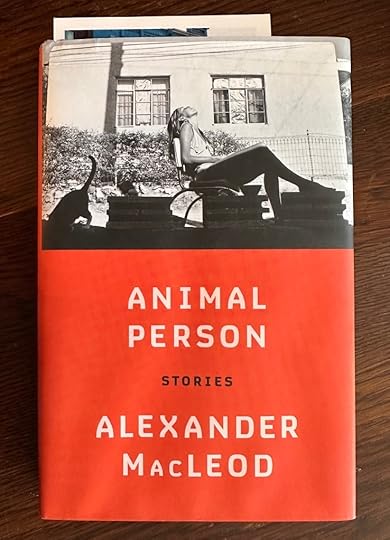
Montgomery admired short stories. “I should like to write some good short stories,” she wrote in her journal not long after she had finished writing The Story Girl. “I consider it a very high form of art. It is easier to write a good novel than a good short story” (January 11, 1911).
(I wrote about Animal Person in a blog post last year. I don’t usually compile “top ten” lists of the best books I’ve read in a given year, but if I did, this book would have been at the top of my list for 2022. If you’re interested but don’t have time to read the whole book, you can read or listen to “Once Removed” on the New Yorker website.)
Over the course of the novel, Sara Ray starts to assemble a collection of decorative china to look at and perhaps use. I like the moment at which Cecily generously gives Sara her forget-me-not jug—“a dainty bit of china, wreathed with dark blue forget-me-nots, which Cecily prized highly, and in which she always kept her toothbrush”—after Sara has been crying about the prospect that Judgment Day will happen the next day at two o’clock in the afternoon. And I was amused to hear Felicity asking if Cecily might also be inclined to give away her cherry vase, something Felicity has long coveted (Chapter 19).
I’m fond of forget-me-not china, and I own a few pieces with Royal Albert’s Memory Lane pattern. I remember talking with my grandmother about china patterns the summer I was ten, when my family spent several weeks in Alberta: we settled on Memory Lane as our favourite. As I mentioned in last week’s post, I was around ten or eleven when I first read The Story Girl, but I have no particular memory of a connection between this scene in the novel and my conversations with my grandmother about forget-me-nots and china.
I do like to think about memories of the past, and I suppose I always have. I hadn’t read Pride and Prejudice back then either, but of course now I always think of Elizabeth telling Darcy to “Think only of the past as its remembrance gives you pleasure” (and of his insistence that sometimes it is appropriate to focus on “painful recollections”).
I don’t have a forget-me-not jug; instead, here’s a photo of a Memory Lane sugar bowl. My grandmother used to keep peppermints in it. I keep it on one of my bookshelves, as “something interesting to look at.”
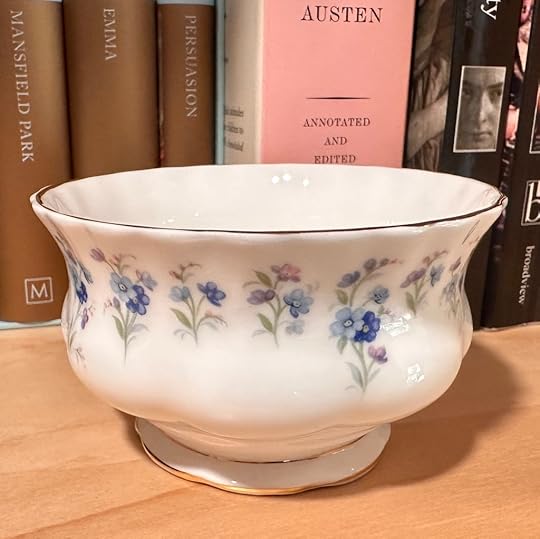
When I read Chapter 16, “The Ghostly Bell,” I thought again of the Story Girl’s words about a hidden tragedy. The sad story of the cancelled wedding prefigures the loss Montgomery talks about in this chapter, the loss of imagination. When Cecily say she wishes they could find a way to get to fairyland, the Story Girl says she believes “there is such a place,” and “there is a way of getting there too, if we could only find it.” Bev as the narrator, looking back on this perfect summer, says she was right that such a place exists, but “only children can find the way to it.” When they are older, “they forget the way”: “they realize what they have lost; and that is the tragedy of life.” It seems to me this loss is the theme of the novel—the tragedy of losing the ability to imagine a world beyond “the common light of common day.”
Only a few people, Bev says, who “remain children at heart,” can still travel to that place: “The world calls them its singers and poets and artists and story-tellers; but they are just people who have never forgotten the way to fairyland.”
Bev’s vision sounds quite wonderful, doesn’t it? But when I look back at the story Sara Stanley has just told about a lady who whisks mortals away to fairyland, bids them drink from a “golden cup with jewels bright,” and makes them forget everything about their ordinary lives on earth, I can’t help but see Keats’s knight-at-arms in “La Belle Dame Sans Merci.” In the poem the knight says he “met a lady in the meads, / Full beautiful—a faery’s child,” who fed him “honey wild, and manna-dew” and took him to her world—which is not an idyllic fairyland, but a place where “pale kings and princes” warned him that “La Belle Dame sans Merci / Thee hath in thrall!” He says,
I saw their starved lips in the gloam,
With horrid warning gaped wide,
And I awoke and found me here,
On the cold hill’s side.
In this passage in The Story Girl, Montgomery seems to suggest that artists and story-tellers are fortunate because they can still find access to a magical world. But the Story Girl’s story also hints at the risks taken by those who travel to “fairyland” and bring back “tidings from that dear country.” From all I’ve read about Montgomery’s struggles as a writer, I think that even as she was celebrating the people who find their way to the world of imagination and bring back news to the rest of us, she was well aware of those risks.
In a later chapter, when the Story Girl tells the tale of the “Serpent Woman,” we get another glimpse of the risks storytellers take. She tells it so well that Bev feels a kind of “repulsion.” Like the knight in Keats’s poem, each member of her audience is enraptured, and yet they all “looked as if they were held prisoners in the bonds of a fearsome spell which they would gladly break but could not” (Chapter 23).
When her tale is told, Uncle Roger and Aunt Olivia predict future fame for the Story Girl. “You and I, Olivia, never had our chance,” Uncle Roger says, and he hopes the Story Girl will have hers. Bev comes to see that “Uncle Roger and Aunt Olivia had both cherished certain dreams and ambitions in youth, but circumstances had denied them their ‘chance’ and those dreams had never been fulfilled.” As I wrote in last week’s post, during the period in which she was writing The Story Girl, Montgomery went through phases of feeling that she had fulfilled her literary dreams, but also at times felt convinced that she would never have a chance at happiness again. Perhaps she is Uncle Roger and Aunt Olivia as well as the Story Girl here. She knows both the sweetness of success and the bitterness of unfulfilled dreams.
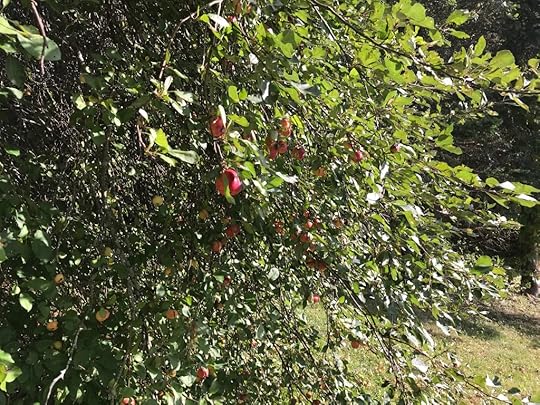
There are so many other things I could say about this book! For one thing, I am intrigued by Sara Ray’s response to the Story Girl’s tale of the woman who stopped speaking to her husband because they had quarreled about an apple tree they planted in their orchard. After five years, when the tree bore fruit at last and she knew she had been right to say it was a Yellow Transparent tree, she said, “I told you so!” (Chapter 21).
And then Sara Ray wants to know what happens next, and whether the woman continues to speak to her husband—a perfectly reasonable question from a reader, I think. But the Story Girl responds “wearily.” She says yes, but insists “that doesn’t belong to the story. It stops when she spoke at last. You’re never satisfied to leave a story where it should stop, Sara Ray.”
Perhaps I’m just imagining the biographical link, but to me this sounds like Montgomery speaking to her readers, who were already starting to demand sequels to her novels. I’m sympathetic to Sara Ray rather than Sara Stanley here. Like Sara Ray, I find that “I always like to know what happens afterwards.”
But on the very next page, my sympathies are with Sara Stanley, the Story Girl. Cecily gives a brief summary of a dream she had, and the Story Girl looks at her “half reproachfully.” “Why couldn’t you tell it better than that? If I had such a dream I could tell it so that everybody would feel as if they had dreamed it, too.” We do want our storytellers to tell stories in a way that makes us feel as if we were there, so that we too experience what John Gardner in The Art of Fiction calls the “vivid and continuous dream.”
And then in the very next chapter, my sympathies are back to Sara Ray again. Bev says unkindly that “There is seldom anything to be said of Sara except to tell where she is. Like Tennyson’s Maud, in one respect at least, Sara is splendidly null.” She is often referred to as “poor Sara Ray.” Bev reminds me here of the narrator of Jane Austen’s Persuasion, talking of Dick Musgrove: “He had, in fact, though his sisters were now doing all they could for him, by calling him ‘poor Richard,’ been nothing better than a thick-headed, unfeeling, unprofitable Dick Musgrove, who had never done anything to entitle himself to more than the abbreviation of his name, living or dead” (Volume 1, Chapter 6). Sara Ray doesn’t receive quite the same harsh treatment, but she is routinely dismissed as unimportant. “Sara Ray’s own dreams never amounted to much,” says Bev (Chapter 22). Maybe she’s more like Anne Elliot in Persuasion, who is seen by her family as “only Anne” (Volume 1, Chapter 1).
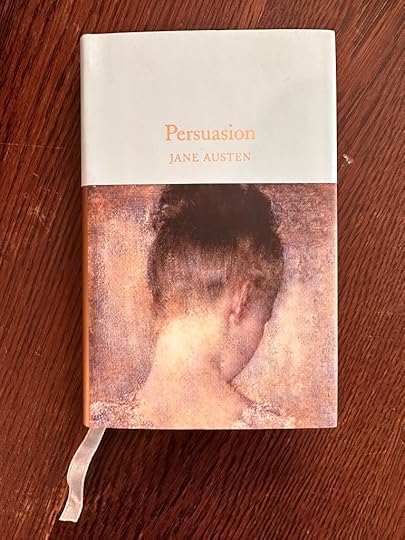
The Story Girl is repeatedly associated with the colour red, and one passage in particular made me think of another book I’m reading this month, Mary Pratt: A Love Affair with Vision, by Anne Koval. In the letter Felicity writes to Peter when he’s recovering from a near-death experience with measles, she describes the “new red dress, and a red velvet cap from Paris” that the Story Girl’s father is going to send her. Felicity herself doesn’t like the colour red because “it looks so common,” which seems to me an unusual perspective.
Koval quotes Mary Pratt’s response to a red velvet dress worn by Susan Hayward in a movie she saw in the 1950s: “I thought this was just beautiful, so I decided to stay for the second showing of the movie.” She became obsessed with the movie, and wanted to own it, but then found that even watching Hayward singing and dancing in that dress wouldn’t be sufficient. “No, that’s not enough,” Pratt said. “I have to be Susan Hayward.” Her ambition went far beyond admiration. “First,” she said, “I want to see that image again; no, I have to own that image; no, I have to be that image.” Koval’s book includes images of Hayward in a red dress, in a publicity photo for With a Song in My Heart, and of Pratt in a strapless red velvet gown.
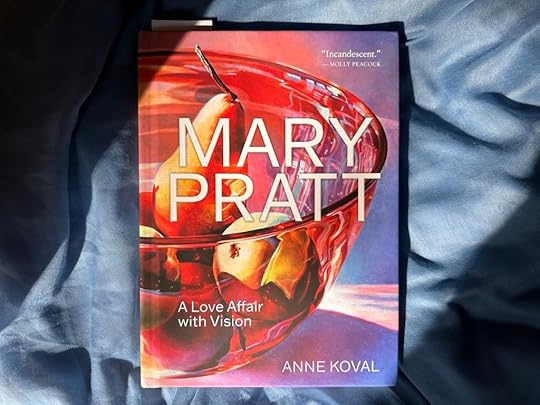
I found it interesting that just before Koval tells this story, she writes of Pratt’s love of Anne of Green Gables. She quotes Pratt’s memory of “driving up the St. John River Valley in the springtime, thinking it was so beautiful, and wishing I could do for New Brunswick what L.M. Montgomery had done for Prince Edward Island.”
In The Golden Road, which I’ve just started reading, the Story Girl says “I’d never get tired of red. … I just love it—it’s so rich and glowing. When I’m dressed in red I always feel ever so much cleverer than in any other colour. Thoughts just crowd into my brain one after the other” (Chapter 3). I don’t know what colour Mary Pratt was wearing when she wrote of her ambition to be like L.M. Montgomery, but I’m going to hazard a guess that she was wearing red.
Here are some photos of the red leaves of autumn in Nova Scotia, taken by Brenda Barry in the Historic Gardens in Annapolis Royal:


Montgomery’s descriptions of autumn in PEI are beautiful. “November dreamed that it was May. The air was soft and mellow, with pale, aerial mists in the valleys and over the leafless beeches on the western hill. The sere stubble fields brooded in glamour, and the sky was pearly blue.”
This is my photo of an August sky, but since it’s “pearly blue,” perhaps we can imagine that it’s either November or May:

Let’s go with May, shall we? Even though it’s November right now. Bev concludes the book by looking back at the beautiful months this band of friends has had together, in which they have known “the sweetness of common joys” and had “brotherhood with wind and star, with books and tales, and hearth fires of autumn.”
Here’s a photo of autumn leaves that I took a couple of weeks ago, on a warm October day:

I’m keen to read more of The Golden Road and I’m looking forward to discussing it with you next week.
I’d like to give Sara Ray the last word. Near the end of The Story Girl, in her letter to Peter, she writes that “We are having beautiful weather and the seenary is fine since the leaves turned. I think there is nothing so pretty as Nature after all” (Chapter 30).
Previous posts about The Story Girl and/or The Golden Road
On my blog:
An Invitation to Read The Story Girl and The Golden Road
An Necklace of Expressive Words
“The best piece of work I have yet done” #ReadingStoryGirl
On Naomi’s blog, Consumed By Ink:
The Story Girl Readalong #ReadingStoryGirl
On Buried in Print:
November 3, 2023
“The best piece of work I have yet done” #ReadingStoryGirl
L.M. Montgomery wrote The Story Girl at a time when she had achieved literary success with her first two novels about Anne Shirley, and was anticipating the day when she would marry her fiancé and move away from her beloved Prince Edward Island. Elizabeth Waterston writes in Magic Island: The Fictions of L.M. Montgomery that Sara Stanley, the heroine of The Story Girl, is “an idealized self-portrait of the author as a young girl.” Waterston writes of Montgomery’s cleverness in “showing off through Sara’s stories the breadth of the range of her interests, while keeping her unsophisticated readers happy with what looks like another visit to the magic island of the Anne books.” As the narrator of the book, Beverley King, looks back on the idyllic childhood summer he spent with his brother and relatives and friends in PEI, Montgomery looks back at the island that has been her home for many years, and prepares to take leave of the people and the place.

My friend Marianne’s copy of the first edition of The Story Girl
(This is part one in a series of posts about The Story Girl and The Golden Road. Naomi MacKinnon and I are hosting a readalong this month and we’re delighted to have your company! We hope you’ll join the conversation in the comments on her blog and mine, and if you write your own posts about the novel online, please share the links with us. #ReadingStoryGirl)
I hadn’t read The Story Girl since I was about ten or eleven, and I had forgotten where it falls in the chronology of Montgomery’s literary career. I was interested to learn that it was her fourth published novel, after Anne of Green Gables in 1908, Anne of Avonlea in 1909, and Kilmeny of the Orchard in 1910. I didn’t realize that it predates the Emily trilogy, her now more famous portrait of an artist as a young girl.
In writing The Story Girl, Montgomery experienced extremes of joy and despair. She began on June 1, 1909, writing in her journal that “The germinal idea has been budding in my brain all winter and this evening I sat me down in my dear white room and began it. I think it is a good idea and I think I shall be able to make a good piece of work out of it. But I feel sad, too, for I cannot be sure that I shall be long enough in this old house to finish it and it seems to me that I could never write it as it should be written anywhere else—that some indefinable, elusive ‘bouquet’ will be missing if it is written elsewhere.”
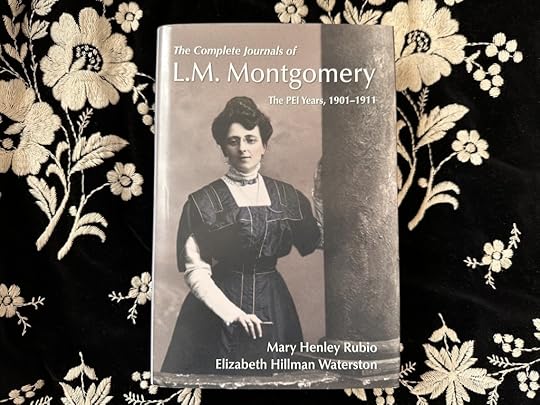
Waterston writes of the joy Montgomery found in writing the opening chapters in the summer and fall of that year, and then of what happened when she stopped working on The Story Girl to produce a quick draft of Kilmeny of the Orchard, to meet her publisher’s demands. On December 23rd, Montgomery wrote that “A fortnight ago I saw that I would not be able to finish it [Kilmeny] at my regular rate of progress, so I have been writing at it every minute since, until I would fairly feel faint with fatigue. But I shall have it done on time.” Her publisher wanted the manuscript by New Year’s.
She met the deadline, but the intensity of the work meant that she had no energy left to return to The Story Girl. In February of 1910, she received a royalty cheque for more than seven thousand dollars, but said “It seems like mockery that this money should come to me now when I am perhaps too broken ever to enjoy it…. There are as yet very few days when I can work. My new book is at a standstill…” (February 19, 1910). She had had what she called “an utter breakdown of body, soul, and spirit” and she believed she was experiencing a form of hell. She felt that “We can endure almost any pain if we can hope that it will pass. But when we are convinced that it will never pass it is unbearable” (February 7, 1910).
Mary Rubio writes that Montgomery told her fiancé, Ewan Macdonald, “of her despondent spirits, and he suggested that she give up her writing. He was unable to see that her writing was an integral part of her spirit and sense of self, and that it was, in fact, what sustained her” (Lucy Maud Montgomery: The Gift of Wings). She found tremendous comfort through the process of writing in her journal and said she couldn’t live without it: “Temperaments like mine must have some outlet, else they become morbid and poisoned by ‘consuming their own smoke.’” (She’s quoting from Thomas Carlyle’s Sartor Resartus.) She resolved “to write out my happiness as well as my pain” (February 11, 1910).
By spring she was able to work on The Story Girl again, and the novel was complete by October of 1910. In September, she was invited to meet the Governor General of Canada, Lord Grey, and in October, she travelled to Boston to meet her publisher. (I’m tempted to write more about that Boston trip sometime.) “I consider ‘The Story Girl’ the best piece of work I have yet done,” she wrote when she reached the end of the novel. “I have written it from sheer love of it and revised it painstakingly—up there by the window of my dear white room. It may be the last book I shall ever write there” (November 29, 1910). I’m glad she got her wish and was able to finish writing the novel in that room. Waterston writes that “Part of its excellence lay in the way it reflected the swings of mood that had beset her.”
The last time I visited the Macneill Homestead, in Cavendish, PEI, where Montgomery wrote The Story Girl, I saw part of the damage that had been done by Hurricane Dorian, including this fallen tree across the old foundation of the house.

This Project Bookmark Canada plaque is located at the Macneill Homestead, and features the text of Montgomery’s poem “The Gable Window,” which describes the view from her room. The poem was published in 1897, when she was twenty-three, and it focuses on “a world of wonder, / When summer days were sweet and long.” (Sounds a lot like The Story Girl, doesn’t it?)

I loved reading the descriptions of the island’s natural beauty in The Story Girl, including Bev’s description in Chapter 2 of what it felt like to explore the old King homestead on the first morning:
I wakened shortly after sunrise. The pale May sunshine was showering through the spruces, and a chill, inspiring wind was tossing the boughs about. …
… we opened the front door and stepped out, rapture swelling in our bosoms. There was a rare breeze from the south blowing to meet us; the shadows of the spruces were long and clear-cut; the exquisite skies of early morning, blue and wind-winnowed, were over us; away to the west, beyond the brook field, was a long valley and a hill purple with firs and laced with still leafless beeches and maples.
This photo doesn’t capture the right time of year or the landscape Montgomery describes, but it is a PEI sunrise, so I thought I’d include it anyway…

August sunrise over Dalvay Lake
I have a few questions for you about The Story Girl. What did you think of L.M. Montgomery’s choice of a male narrator? I think it’s interesting that after the first two novels about Anne Shirley, she wrote two novels from the point of view of a male character—even though Kilmeny and the Story Girl are still at the centre of both books (Kilmeny of the Orchard is narrated by Eric Marshall, a schoolteacher). As a storyteller, how does Bev King compare with Sara Stanley, the Story Girl?
(Also—would you like to read Kilmeny of the Orchard with me sometime? Maybe this could be our focus for a future readalong.)
I have to say I have some reservations about Bev as a narrator. I’m not sure I believe him when, for example, after describing the Story Girl with her arms full of roses and a “chaplet” of them in her curls, he claims that “We always remembered the picture she made there; and, in later days, when we read Tennyson’s poems at a college desk, we knew exactly how an oread, peering through the green leaves on some haunted knoll of many fountained Ida, must look” (Chapter 18). Who is the ”we” here? Can it really include Felix, Felicity, Peter, and the others, or is he speaking only of himself? (Or is this even Bev speaking—it sounds to me more like Montgomery herself.)
Waterston suggests Montgomery might have chosen a male narrator in an effort to reach a wider audience than the one she had found with her Anne novels, or that she might have “intended to mollify literary critics, who generally assumed that a male point of view was more significant than a female one.”
What do you make of Bev’s comments on how “we liked the prospect of our summer very much. Felicity to look at—the Story Girl to tell us tales of wonder—Cecily to admire us—Dan and Peter to play with—what more could reasonable fellows want?” My friend Marianne says this passage is “sort of awful,” and I agree.
Later in the novel, however, Marianne says she feels that Bev has “partly redeemed his early comment about the girls”: she writes that “in chapter 14, Forbidden Fruit, Cecily proves to be the hero when Dan eats a handful of ‘bad berries.’ Our narrator says, ‘Cecily took charge of things. Felicity might charm the palate, and the Story Girl bind the captive soul; but when pain and sickness wrung the brow, it was Cecily who was the ministering angel.” Then, she says, “in chapter 19, when the children fear the next day will be Judgment Day and Sara Ray can’t stop weeping, our narrator says, ‘Cecily and Felicity and the Story Girl did not cry. They were made of finer, firmer stuff. Dry-eyed, with such courage as they might muster, they faced whatever might be in store for them.” So, Marianne concludes, “I feel a little better about Bev’s stance on ‘the fairer sex’ (not his words). He seems to learn that girls have value beyond being nice to look at.”

Dalvay Lake, later in the day
What did you think of the stories themselves? Did you find the Story Girl as “fascinating” as Bev and the others say she is? “Yes, the Story Girl was fascinating and that was the final word to be said on the subject” (Chapter 3).
Why are there two girls named Sara in this book? Sara Stanley is the Story Girl, while Sara Ray is a “nice girl” with a “dreadfully strict” mother who “never allows Sara to read a book.” The contrast between the two is clear, but I think it would have been pretty clear even if they didn’t share the same name.
(I’ve always wondered why neither of them has an “h” at the end of her name, I suppose because I feel as attached to the “h” in my own name as Anne Shirley is to her “e.”)
Next Friday, I’ll write more about The Story Girl, and after that let’s turn to the sequel, The Golden Road.
Previous posts about The Story Girl and/or The Golden Road
On my blog:
An Invitation to Read The Story Girl and The Golden Road
An Necklace of Expressive Words
On Naomi’s blog, Consumed By Ink:
October 27, 2023
A Necklace of Expressive Words
“… feeling all the happy privilege of country liberty, of wandering from place to place in free and luxurious solitude, she resolved to spend almost every hour of every day while she remained with the Palmers, in the indulgence of such solitary rambles.”

I went in search of a Jane Austen quotation to accompany this stereoscopic card captioned “Solitude, Fairmount Park, Philadelphia,” which I found in an antiques shop in Mahone Bay, Nova Scotia last Sunday, and I settled on this passage from Sense and Sensibility (Volume 3, Chapter 7). (I don’t own a stereoscope, but I liked the image and bought the card anyway.) Within five minutes of her arrival, Marianne Dashwood has slipped away to walk “through the winding shrubberies, now just beginning to be in beauty, to gain a distant eminence; where, from its Grecian temple, her eye, wandering over a wide tract of country to the south-east, could fondly rest on the farthest ridge of hills in the horizon, and fancy that from their summits Combe Magna might be seen.”
Jane Austen captures the torments of Marianne’s mind and heart beautifully here, showing how closely pleasure and pain are linked: “In such moments of precious, invaluable misery, she rejoiced in tears of agony to be at Cleveland,” staying with the Palmers in a house so near to Willoughby’s, indulging in and even enjoying her sorrows and longings.
I found an old Friends of Chawton House membership card tucked into one of my copies of Sense and Sensibility:
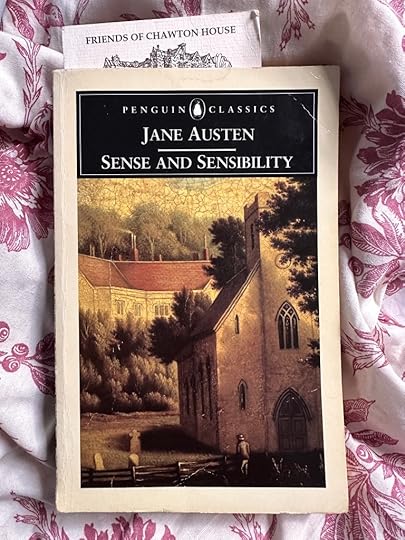
After that road trip to Mahone Bay on Sunday, I saw this gorgeous sunset over the Macdonald Bridge, which links Halifax and Dartmouth, so I stopped to take a picture.

Looking across to Halifax, Georges Island, and McNabs Island from the Dartmouth waterfront:

I’m reading L.M. Montgomery’s novel The Story Girl, preparing for next month’s readalong. I’m only a few chapters in and will be keen to read more this weekend. My friend Naomi, who’s co-hosting the readalong with me, wrote about the book in a recent blog post that includes a variety of cover images for The Story Girl and The Golden Road.
As I’m sure I’ve mentioned here before, I’m partial to the covers created by Elly MacKay for the Tundra editions.

I also loved seeing this beautiful first edition of The Story Girl, which belongs to my friend Marianne:

It occurred to me that the word “solitude” is very likely important to Sara Stanley, the Story Girl, as well as to Marianne Dashwood, so I searched and found a passage in which Sara defends the word “deviltry,” which her friend Felicity believes to be a swear word. Sara explains that the word “only means extra bad mischief” and Felicity insists “it’s not a very nice word, anyhow.” Sara regrets that “It’s very expressive, but it isn’t nice. That is the way with so many words. They’re expressive, but they’re not nice, and so a girl can’t use them.”
She sighs, and Montgomery tells us, “She loved expressive words, and treasured them as some girls might have treasured jewels. To her, they were as lustrous pearls, threaded on the crimson cord of a vivid fancy. When she met with a new one she uttered it over and over to herself in solitude, weighing it, caressing it, infusing it with the radiance of her voice, making it her own in all its possibilities forever” (Chapter 21).
Isn’t that a lovely image, of a necklace or bracelet made of expressive words? I’m often drawn to jewellery that features words or quotations, including a silver bracelet I bought from JASNA’s New York Region several years ago—“Teach us … that we may feel the importance of every day, of every hour, as it passes” (from one of Jane Austen’s prayers)—and a leather bracelet my friend Lisa gave me as a birthday present—“I declare after all there is no enjoyment like reading! How much sooner one tires of anything than of a book!—When I have a house of my own, I shall be miserable if I have not an excellent library” (from Pride and Prejudice).
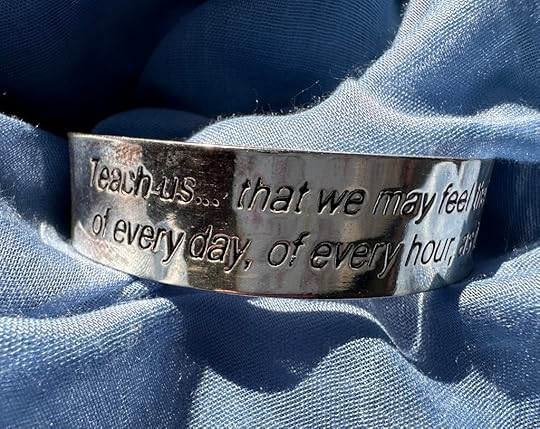
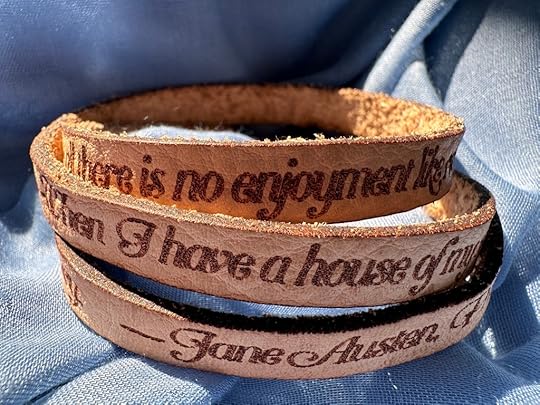
I also have a name bracelet made my teenage friend Sofia, creator of Fia Bijoux, a jewellery business she founded when she was twelve. (Her jewellery is beautiful and she donates 20% of all profits to the Holland Bloorview Kids Rehabilitation Hospital in Toronto.)

I asked Sofia for green and blue beads, two of my favourite colours, and I love the turquoise letter beads because they remind me of Jane Austen’s turquoise ring and turquoise beaded bracelet.
Do any of you have favourite jewellery that features words, names, or quotations?
Now I’m picturing a necklace with words from L.M. Montgomery’s novels, including “deviltry,” “scrumptious”—“Oh, Marilla, I’ve had a perfectly scrumptious time. Scrumptious is a new word I learned today…. Isn’t it very expressive?” (Anne of Green Gables, Chapter 14)—and “fascinating”—“Yes, The Story Girl WAS fascinating and that was the final word to be said on the subject” (The Story Girl, Chapter 4).
October 20, 2023
“There are two ways of spreading light”
Edith Wharton wrote that “There are two ways of spreading light: to be / The candle or the mirror that reflects it.” I’m going to revise the ending of the quotation slightly so I can use it as a caption for this photo, and say “or the piano that reflects it.” These lines are from her poem “Vesalius in Zante,” published in the North American Review in 1902.

For today’s scrapbook blog post, I want to share some of the things I’ve enjoyed seeing or reading about over the past week: an exhibition of quilts, a short video featuring Ursula K. Le Guin, a mother-daughter road trip to PEI, and a new novel for fans of Jane Austen.
Last week, I went to the opening of “By Her Hand: Contemporary Quilts Inspired by the Nova Scotia Museum,” an exhibition of stunning quilts created by Andrea Tsang Jackson and Marilyn Smulders. Marilyn is a friend of mine, and I’m the proud owner of a gorgeous quilt she made a few years ago, entitled “Homage to the Homage to the Square.” I was delighted to see that quilt in the background of Marilyn’s photo. If you’re in Halifax in the coming months, you should go see the exhibition, which is on at the Museum of Natural History until January 7th.

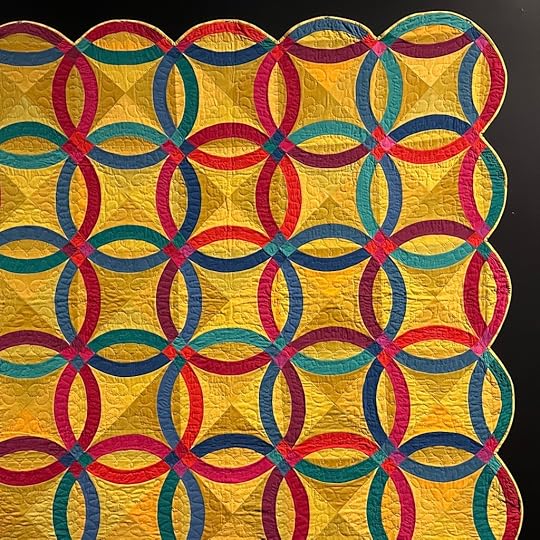
“He’s my first reader,” Ursula K. Le Guin says of her husband, Charles, in a delightful interview with the two of them, sitting by the fire in the house they shared for decades. I’ve read very little of her work and would like to explore further. Do any of you have suggestions?
I enjoyed this essay about a road trip to Prince Edward Island: “Road to Avonlea: Amanda Parrish Morgan on the Transportive Intimacy of Reading and Long Drives.” Morgan writes that “Reading a book aloud, especially to a child, means getting on that frigate together, being passengers in the same car, not just with a character with whom we might feel like kindred spirits, but with each other. The car, the book, the trip—all means of getting somewhere unknown together.”
Here’s my photo of the view from the Confederation Bridge, from a road trip to PEI several years ago. Stopping on this narrow bridge isn’t allowed, but on this occasion, we had to stop because of construction, so I was able to take a photo. Morgan says that although she isn’t a nervous driver, she found it challenging to drive over this eight mile bridge: “it required mantras and affirmations like those I’d used during childbirth or in the final miles of a marathon.”

Happily for Morgan, she found that “The bridge and the terror it induced seemed, somehow, to make the rolling hills of PEI and the sweet reconstructions of Anne’s world all the more bucolic.”
One of my photos from a family holiday in PEI a couple of years ago:

Jane Austen fans might be interested in Stephanie Barron’s new novel, Jane and the Final Mystery, the last in a series of fifteen mysteries that started with Jane and the Unpleasantness at Scargrave Manor. My friend Laurel Ann Nattress of Austenprose.com writes that this last novel is “a poignant, compelling, and uplifting story.” She says “the immaculately researched mysteries are standalone stories, so please do not hesitate to jump right in with book fifteen, and then circle back to any of the previous novels.” I’ve read a few of the books in the series, and I have a particular fondness for Jane and the Ghosts of Netley. Do any of you have a favourite Stephanie Barron novel you’d like to recommend?

I’ll leave you with one last photo, of our dog, June, keeping me company in my office.
